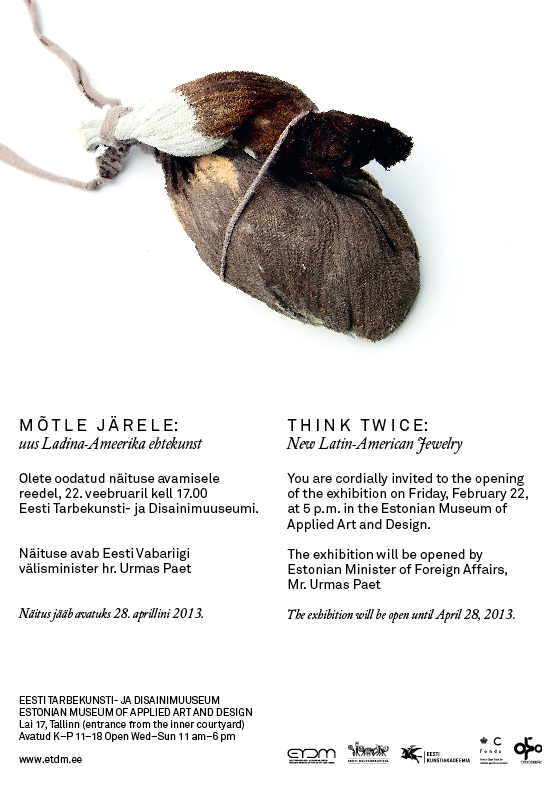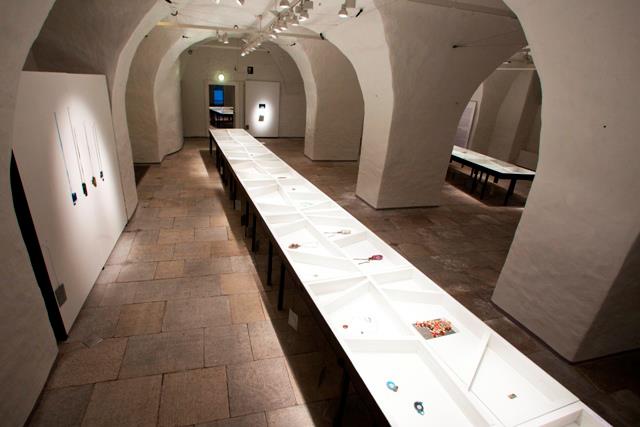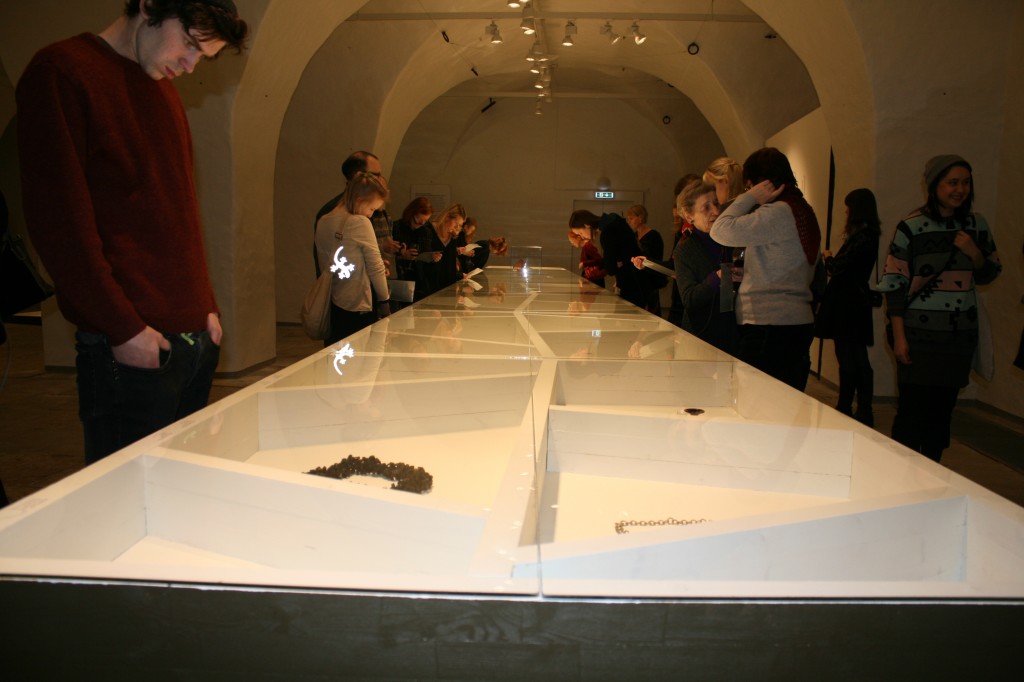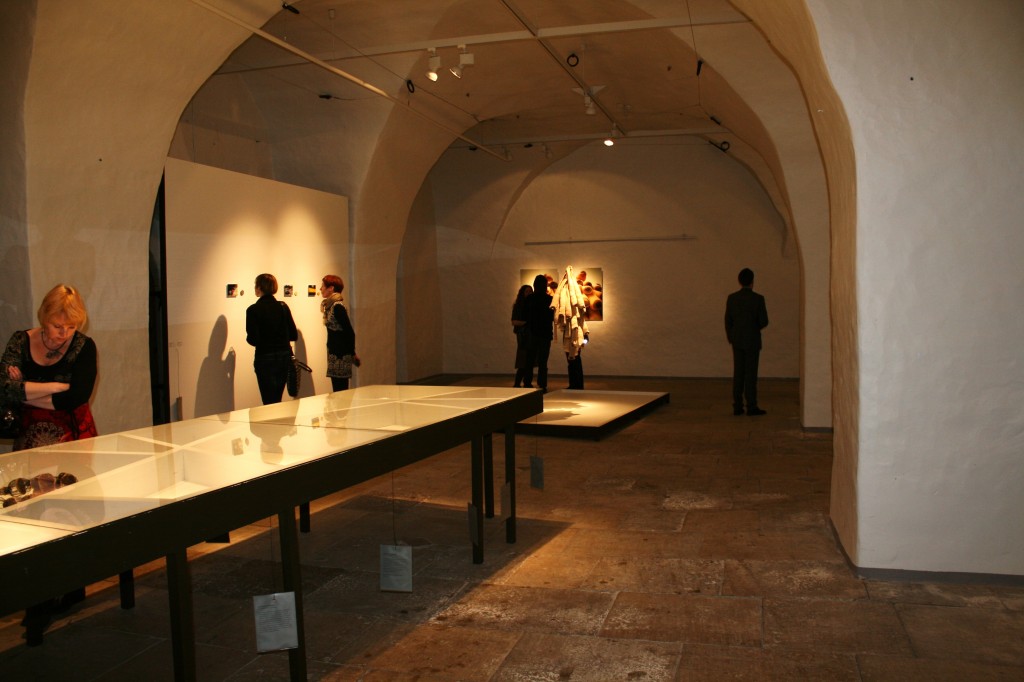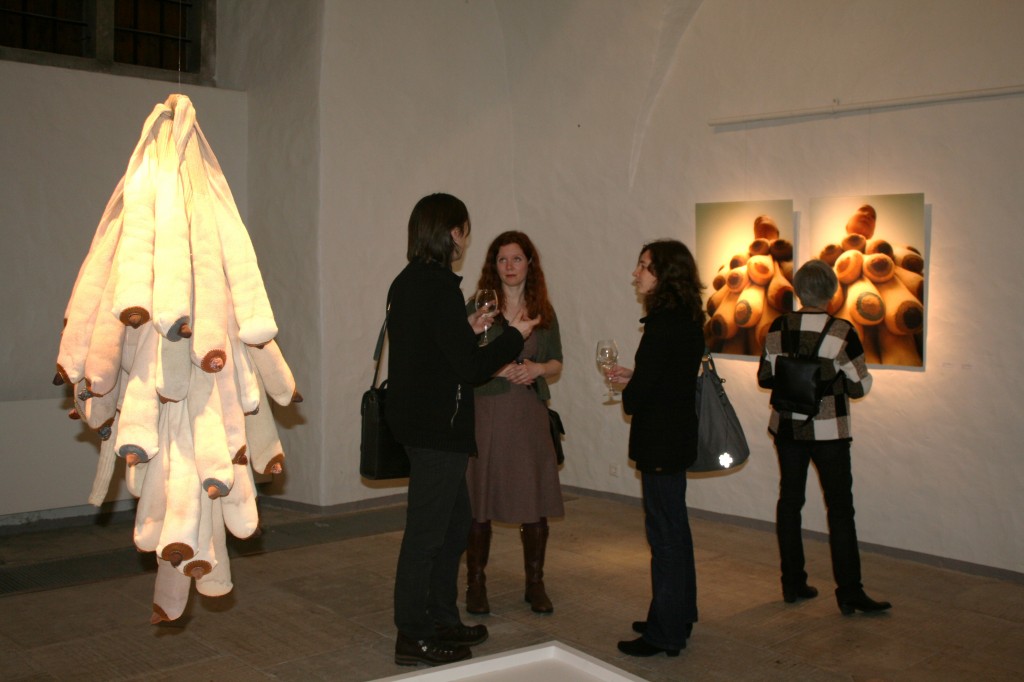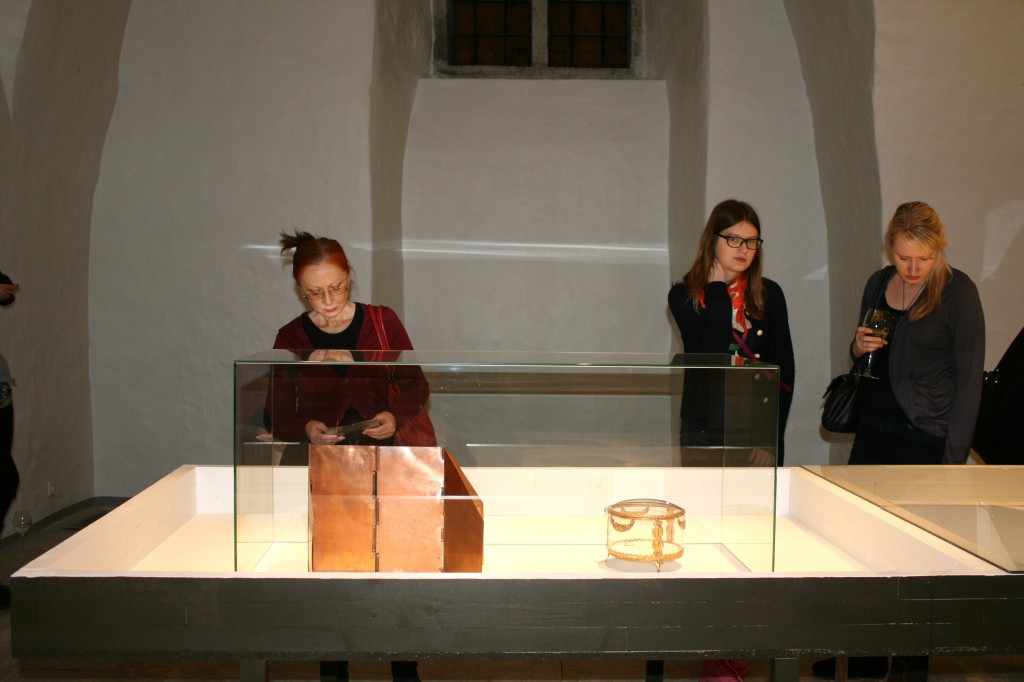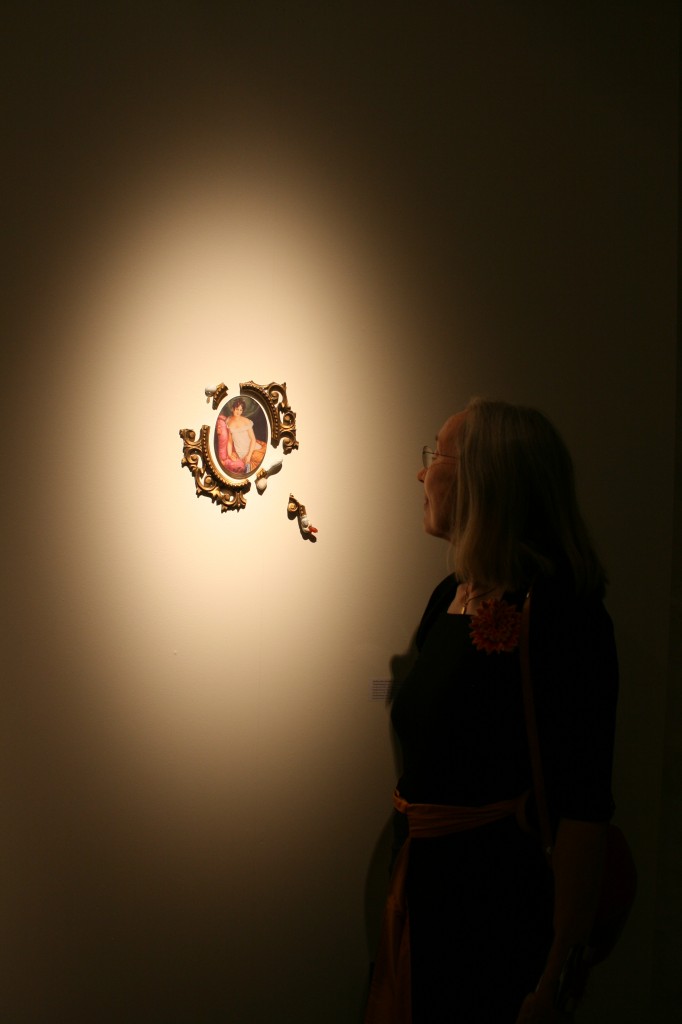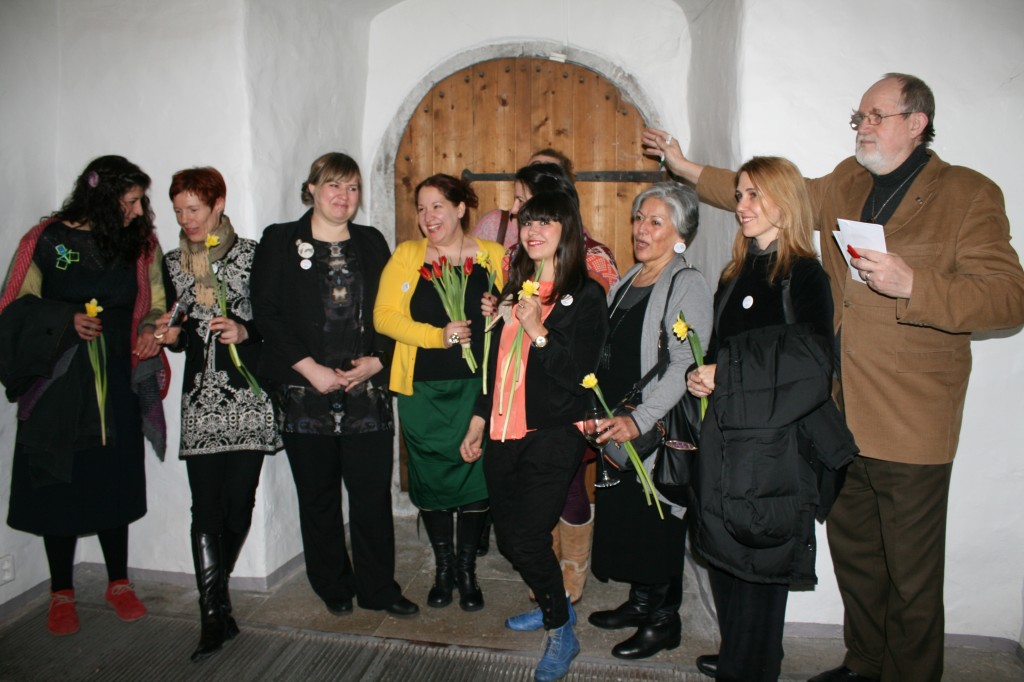Mirla Fernandes
I have a tendency to make connections with other disciplines when I am looking at an Art-Jewelry piece. The points of connections with drawing and jewellery are particularly interesting for me. I’ve been researching this dialogue for a long time .
When I meet an artist that is somehow working on the same subject, at least in my point of view, I find it stimulating. I see other solutions for the inner questions I ask myself all the time: the crossing over the two dimensions world into the three-dimensional one.
Many of us are familiar with Doris Betz pieces, where she reveals her concern with lines , transforming the graphite of a pencil into silver lines looking for spontainity.
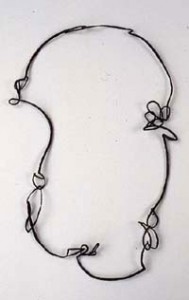
Doris Betz
There is also the coloful work of Liana Pattihis recently published at Dreaming Jewelry from Monsa Publishers showing not only her peculiar enamel procedings, but at least for me, a profusion of lines that are vigorous in its intense red tones.
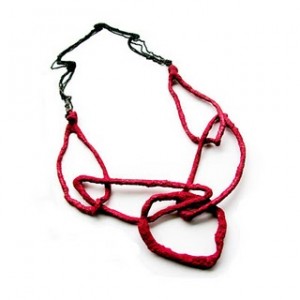
Liana Patthis
Last week I saw some of the works of Hena Lee that can be seen as working somehow in this direction.
With a background in architecture, the brazilian artist has participated in NOVAJOIA’s workshops with Ela Bauer (october 2009) and Karin Seufert & Tore Svensson (november 2009). Since then she started to develop a jewellery work that, to me, dialogues with drawing.
The change started from questioning herself about her own identity. The chosen materials revealed her korean inheritance: sesame, pepper powder and chopsticks.
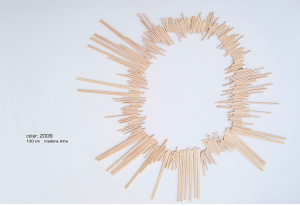
The chopsticks were initialy used in its natural colors. Once painted in black ,they started to bring a very strong graphic quality to the work.
The developments of the most recent pieces are showing an increase of its graphic qualities. The thick and hard line of the choptsticks are giving space to the flexible and light cotton thread. The line that was holding the pieces together now is also working as a plastic element.
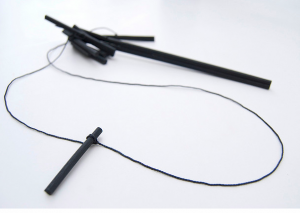
When there is color, it is punctual.
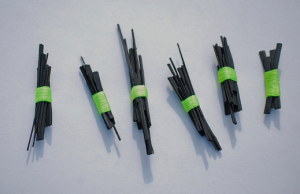
The domain of the black, as FRUTIGER explains, works removing the light, emphasizing the space around, activating it. We see in these pieces drawings that go further in the three-dimensional space.
Hena Lee is one of the brazilian artists in Think Again, opening next october 12th (MAD/NY).
about : FRUTIGER, Adrian. Sinais & Símbolos. São Paulo: Ed. Martins Fontes, 2001.
Guigui Kohon
It all started from several questions about what I do: what is my work as a jeweler, and that’s how I began to do some research on open pit mines, established in breathtaking, secluded locations, hidden from the view and knowledge of people.
Todo empezó a partir de varios cuestionamientos sobre mi trabajo, y fue así que empecé a investigar sobre las minas a cielo abierto, ubicadas en espectaculares parajes inaccesibles, escondidas a los ojos y al conocimiento de los pueblos.
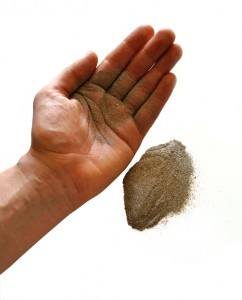
…”The 100 brooches-medals, filled with waste from the matter that is left after creating the pieces of jewelry, make a transgressive statement. Their serial reproduction deactivates the concept of uniqueness and, therefore, questions the social role of pieces of jewelry as amplifiers of identities. Dust becomes an image of fragmentation, dissolution and homogenization of shared identities in crisis, in a world which is on the verge of self-destruction. Their appearance of brooches-lockets re-connects us to a dark, shared origin within the womb of the earth, which may help us redeem and protect ourselves, as the ancient charms of primitive men when they believed in the need to restore the balance with their environment, broken by their hunting and food collection activities.”
Ramon Puig Cuyàs, May 2010.
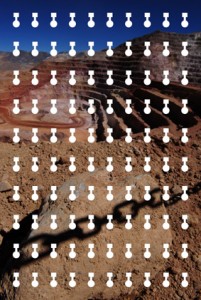
…”Los 100 broches-medalla, rellenos de los residuos que quedan de de las materias expresivas después de hacer sus joyas, se manifiestan con voluntad transgresora. Su multiplicación seriada provoca la desactivación de lo singular, y por lo tanto el cuestionamiento de la función social de la joya como amplificadora de identidades. El polvo se convierte en imagen de la fragmentación, la disolución y la homogenización de identidades compartidas en un mundo en crisis, en un mundo asomado al abismo de la autodestrucción. Pero además su aspecto de broches-relicario les confiere la capacidad de re-ligarnos a un oscuro origen compartido, que se hallaba en las entrañas de la tierra, y que pueden ayudar a redimirnos y a protegernos, como lo hacían los antiguos amuletos del hombre primitivo cuando creía en la necesidad de restablecer la armonía con su entorno, rota por sus actividades de caza y recolección.”
Ramon Puig Cuyàs , Mayo 2010
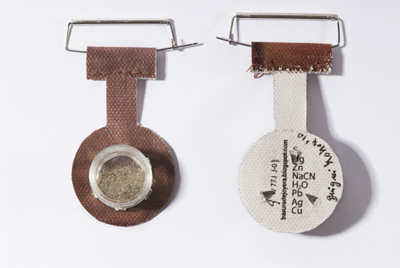
Brooch: Fragment of the picture of the open pit mine Veladero in San Juan, Argentina, and silver sweeps-filings from my workbench.
Broche: Fragmento de foto de la mina a cielo abierto de Veladero, en San Juan, Argentina, y mi polvo-basura de plata (de mesa mi de joyería).
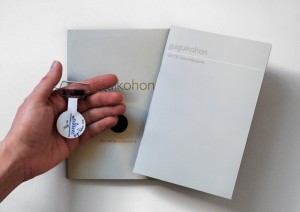
Thus was edited these 100 books, containing 100 pins.
Y… así fué como se editaron estos 100 libros que contienen los 100 broches.
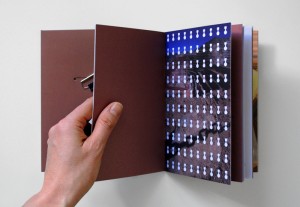
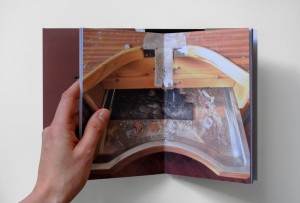
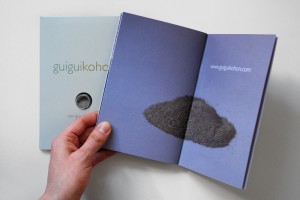
Every year, thousands of six-pack rings threaten the lives of shore birds and marine animals harming our environment.
Greencard Creative, a multidisciplinary agency that creates, transforms and promotes brands, movements and initiatives from and to the American Latino audience in the US and in Latin America and often focused in environmental and social matters, has developed Origomu, a project that promotes to promote environmental awareness through design. Origomu is a technique that uses the plastic six-pack rings used to hold together six-packs of beer and soda cans to create jewellery.
Greencard Creative has created a contest to select and award the best three pieces:
1st Prize $5,000
2nd Prize $2,000
3rd Prize $1,000
And to feature the best 500 pieces in a book published by Taschen Books.
Although the contest was originally targeted to the general public (so visitors of this blog are kindly invited to participate), Otro Diseno believes that Jewellery has a tremendous power to communicate and its portability makes it an ideal media to promote awareness on matters as important as this one. We are convinced that the limitless talent and ability to transform, create and communicate though ornaments that you jewellery-makers have, would make a remarkable contribution to the Origomu initiative. Therefore, we would like to invite you all to take part of this project which we hope you will find challenging, encouraging and important enough.
The only premise is to use plastic six-pack rings as part of your piece. You can either learn the Origomu technique explained at the Origomu site of the create your own. The rings can be manipulated any way you can think of and can be combined with all kinds of materials. The format is free and you can present up to five pieces (or a series of five).
To enter the contest, all entry forms and photos of your finished work must be submitted before November 30th, no later than 11:59PM US East Time.
Please, vist the Origomu webpage to learn more about the project.
http://www.origomu.com/participate.php
We are sure that many of you will be able to make a good statement about this important matter. We hope thatyou will be challenged by smart initiative and that the Taschen book will feature the work of many of you.
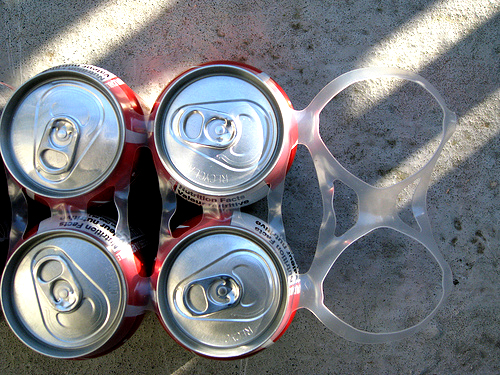
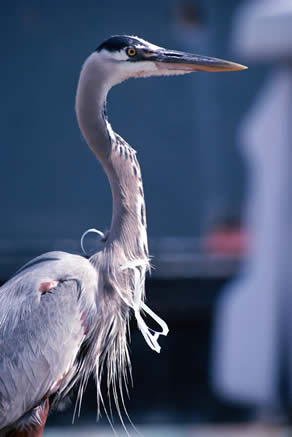
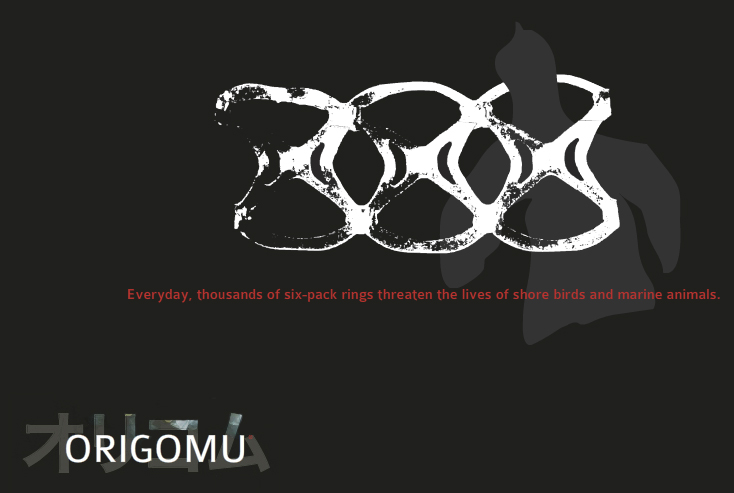
The Otro Diseño Foundation Foundation is proud to announce the opening of Think Twice: New Latin American Jewellery, to take place at the Museum of Art and Design (MAD) in New York from October 12, 2010 through January 8, 2011.
Think Twice, curated by the Netherlands-based, Mexican-born architect and historian Valeria Vallarta Siemelink, is the largest exhibition of contemporary jewellery from Latin America ever organized and it will tour around the Americas and Europe during the next few years.
This exhibition, featuring over 125 pieces, aims to offer the audience a glimpse of the history of contemporary jewellery in Latin America (through a small collection that contain pieces from the 1940′s and to the 1990′s) and comprehensive view of its development in the last 10 years, by showing the way in which visual artists and jewellery makers born or living in Latin America view and relate, through jewellery, to the continent. The exhibition has been organized in three idle groups (History, memory and Tradition, A Flair for Invention and Latin America as a Source of Inspiration) which, rather than imposing a rigorous system of classification, they attempt to give sense to a broad and diverse selection. So, many of the works that compose this collection could easily fit into more that one of these groups. The collection as a whole reflects the continent’s historical development, dynamic mix of cultures and its socio-political realities, all of which are constantly transforming themselves.
The Ca. 85 artists that take part of this exhibition show that Latin American jewellery today is tremendously varied in its scope: figurative or abstract, conceptual or symbolic, traditional or experimental. It intersects between the conventionally distinct categories of craft, visual art, and design and fusses seemingly diverse references, concepts and materials. Able to generate both national and transnational communication, it all has been made by committed jewellery makers, heirs to a millenary tradition and part of a culture in which jewellery is a common language.
Think Again, developed by the Otro Diseño Foundation, is born out of a passion for jewellery as a medium of personal and cultural expression and of the conviction that the fresh, intense and highly creative work of Latin American jewellery makers outstandingly represents and nurtures the culture they live in and therefore greatly enriches and diversifies the international landscape of contemporary jewellery.
As commented by Urusula Newman, Jewellery Curator at the MAD “This is a very special show. This jewellery is virtually unknown in the United States. The artists’ realize their sophisticated concepts through intriguing choices of materials and techniques, creating unique works that present a fascinating amalgam of indigenous cultural elements and the latest trends in international contemporary jewellery design”.
This exhibition represent a tremendous achievement in the promotion of contemporary jewellery for Latin America and a huge effort by the Otro Diseño Foundation, the participant artists and all the museums that have generously decided to host the exhibition.
We hope that many of you will have the chance to visit the exhibition at the MAD or at any other of its future venues.
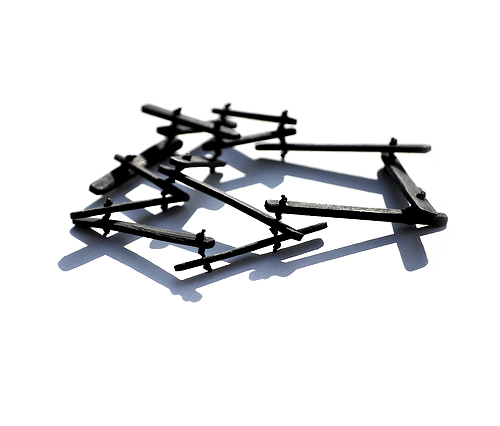
Hena Lee, Brazil
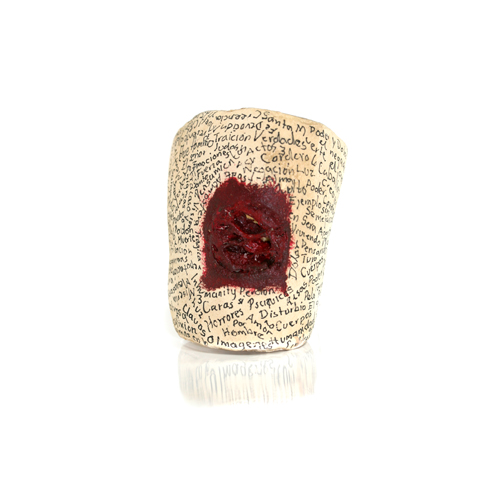 Jorge Manilla, Mexico-Belgica Jorge Manilla, Mexico-Belgica
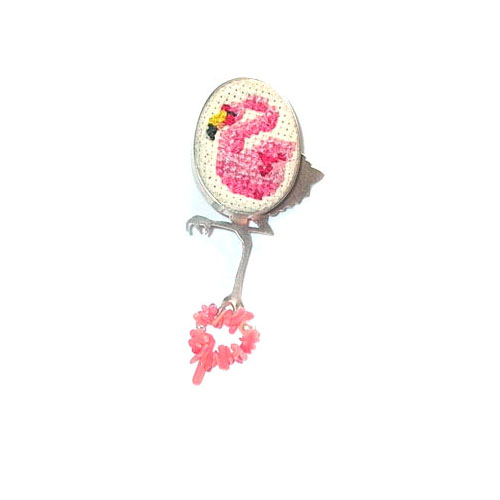 Jimena Rios, Argentina Jimena Rios, Argentina
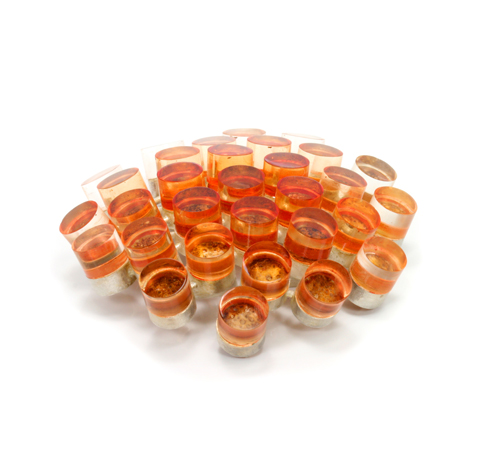 Claudia Cucchi, Brazil-Italia Claudia Cucchi, Brazil-Italia
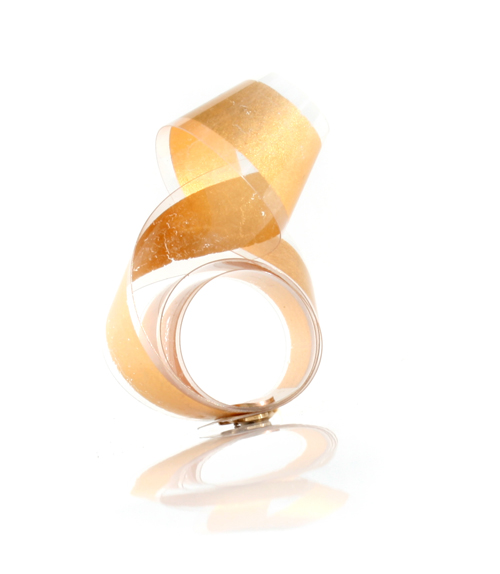
Martha Camargo, Colombia
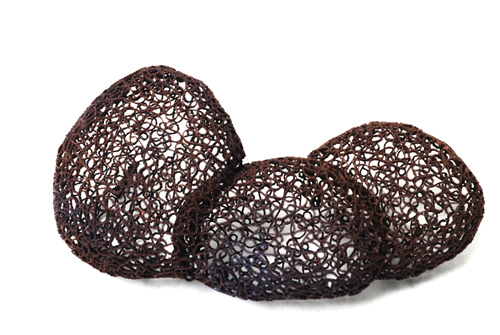
Ximena Briceno, Peru-Australia
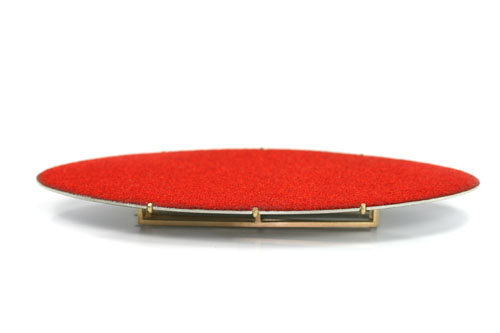 Nilton Cunha, Brazil Nilton Cunha, Brazil
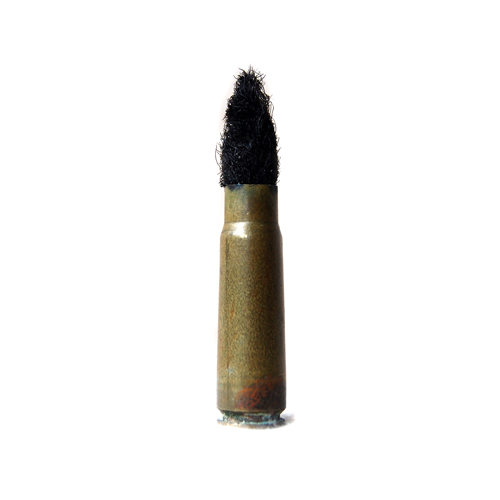 Carlos Martiel, Cuba Carlos Martiel, Cuba
 Carlos Castanon, Argentina Carlos Castanon, Argentina
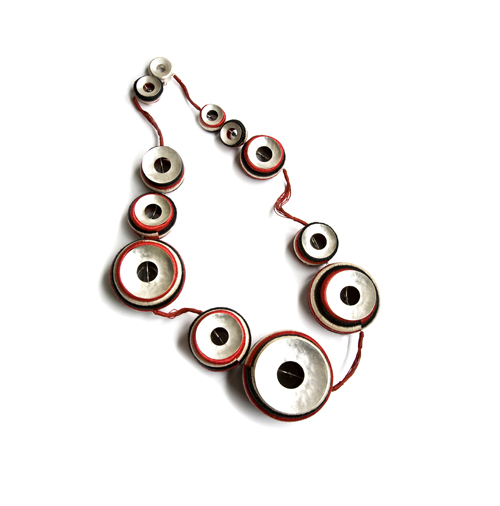 Linda Sanchez, Colombia Linda Sanchez, Colombia
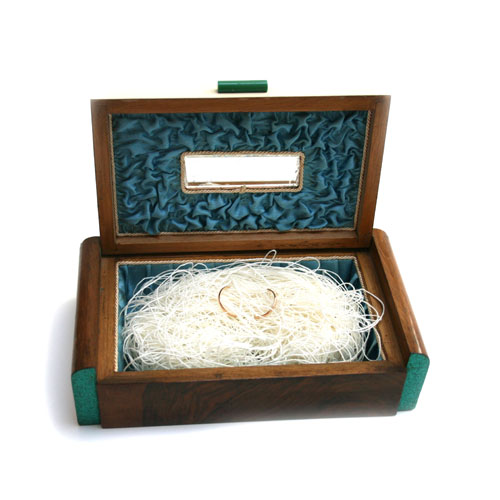 Dani Soter, Brazil Dani Soter, Brazil
 Art Smith, Cuba/Jamaica-USA Art Smith, Cuba/Jamaica-USA
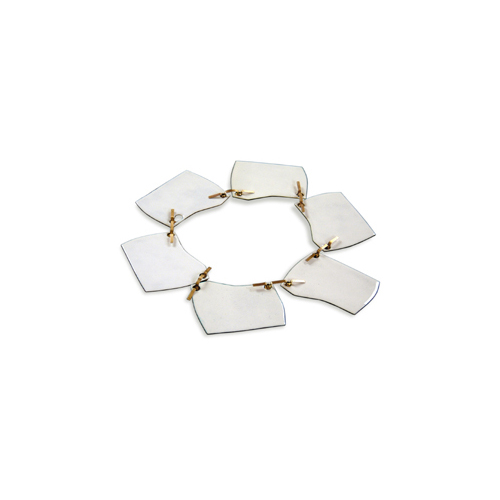 Beat Eissmann, Germany-Mexico Beat Eissmann, Germany-Mexico
 Carolina Hornauer, Chile Carolina Hornauer, Chile

Reny Golcman, Brazil
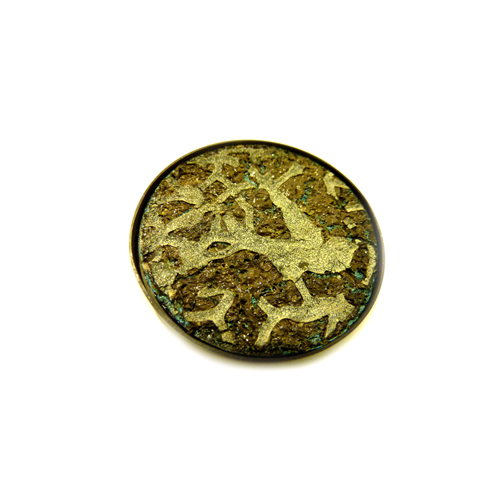 Helena Biermann, Colombia-Alemania Helena Biermann, Colombia-Alemania
 Leda Daverio, Argentina Leda Daverio, Argentina
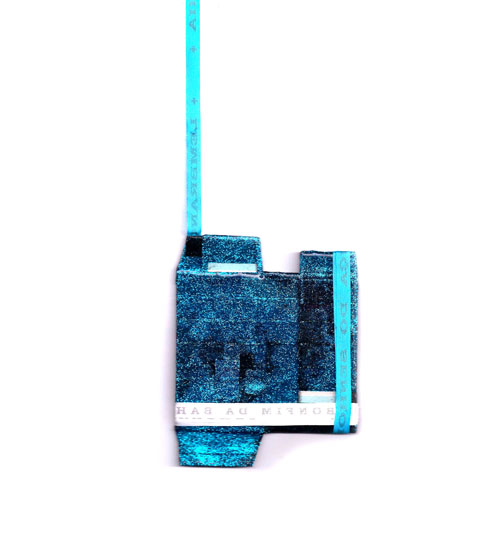 Celio Braga, Brazil Celio Braga, Brazil
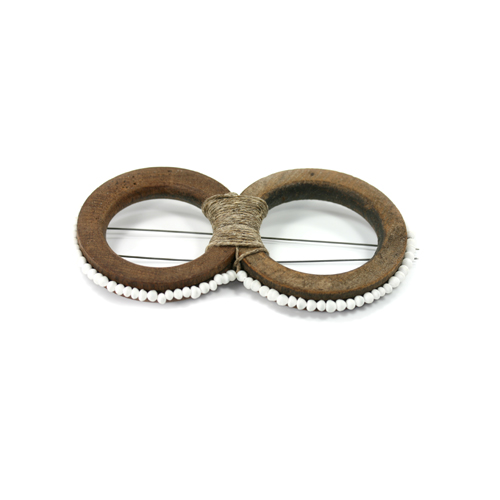 Chequita Nahar, Surinam Chequita Nahar, Surinam
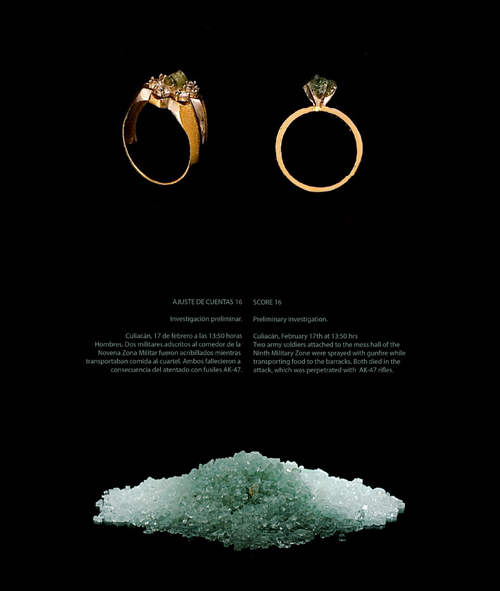 Teresa Margolles, Mexico Teresa Margolles, Mexico
Mirla Fernandes
If in Amsterdam Art Jewelry is taught at an Art School such as Gerrit Rietveld and in Munich it is also taught at the Kunst Akademie, in Brazil we have jewelry classes squeezed among fashion or design courses with a very commercial and industrial orientation.
Since 2007, I’ve been committed to expand the scene of art jewelry in Brazil through the NOVAJOIA project. As I said here before, one of the main concerns is related to education. The year 2010 has proved to be an important one, once we are getting closer to the art colleges.
The first step happened in August with the ‘Nova Joalheria’ (New Jewellery) inside the Core of Culture Department of Fundação Armando Alvares Penteado (FAAP) one of the best art colleges in São Paulo where I am teaching practical and theoretical classes.
The second one was given by Ana Paula de Campos, a brazilian jewelry artist, a teacher with more than 15 years of experience and a very active collaborator of NOVAJOIA.
After going to Gray Area Symposium to talk about education in Brazil, she has invited Cristina Filipe (that also coordinates the jewelry department at Ar.Co, Lisbon) to come to give a workshop as part of the post-graduation program in Arts of UNICAMP (University of Campinas, São Paulo).
So now, in September, Filipe has been in São Paulo for a complete program. She has given a lecture and participated in a round table along side with teachers and coordinators of UNICAMP: Prof. Dra. Anna Paula Gouveia, Prof. Dr. Edson Pfutzenreuter and Prof. Dra. Maria de Fátima Morethy Couto.
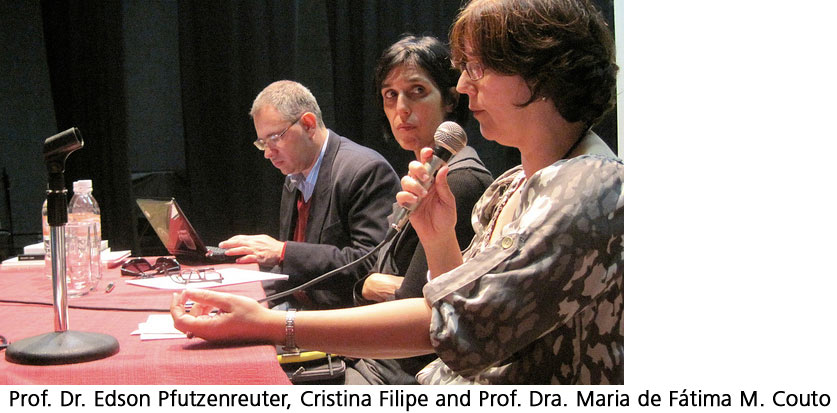
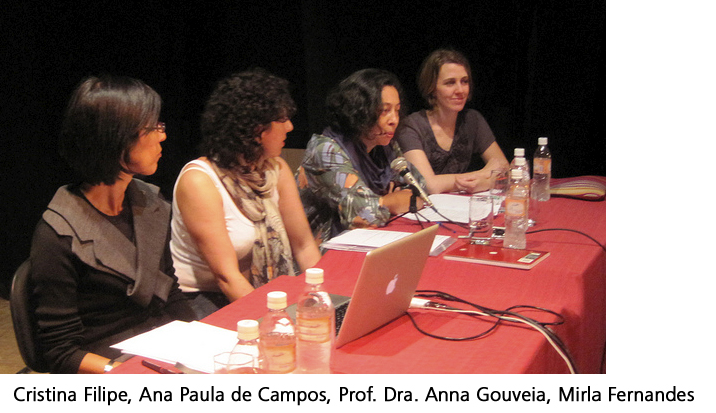
With a very conceptual work that goes beyond traditional jewelry ways of expression, going further on using medias such as photography and video, the quality of Filipe’s works and words were crucial to the positive reception of Art Jewelry in this academic environment.
After the round-table, Filipe has given workshop and once the University belongs to the government, the course was free of charge. I had the opportunity to be one of the assistants during these days and it was great to see 18 students of different backgrounds getting in touch for the first time with art jewelry practices and thinking.As a result of this meeting, we had an open door to the art-jewelry in the Art Department of one of the most important universities in the country.
After all, what does it mean? Getting closer to the institutions may provide more opportunities for international guest artists to come. This means different ways of thinking, the enhancement of the dialogue between art jewelry creators globally, what can be productive for all sides.
The Art Jewelry world is small and Latin Americans have a certain feeling of isolation of the scene. These efforts of interchange are slowly growing allowing to reach broader audiences. One step at a time, let’s hope for the best in the future.
To see pictures of the workshop, click on the following link:
http://www.flickr.com/photos/mirlaf/sets/72157624819856783/
Mirla Fernandes
Yesterday was the opening of 29º Bienal de São Paulo, an international art event that brings art works from all over the world to São Paulo and the second event that brings more tourists for the city in the year.
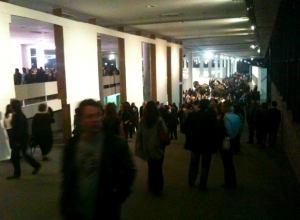
I’ve been there and I share some pics and videos I made with my phone…I believe some of you will remember Gray Area Symposium…I remembered a lot because of the work of Ana Gallardo, “Un lugar para vivir cuando seamos viejos”, who invited danzon mexican dancers Don Raul, Lucio and Conchita to come to São Paulo and give lessons during the Biennial!
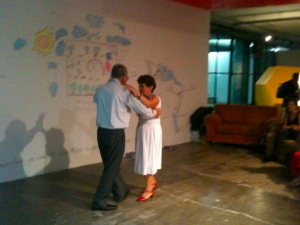 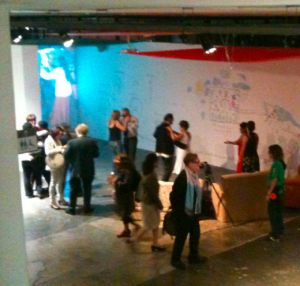
So many interesting works in three floors of the pavillion. I spent more than two hours and still did not get a good view of it all. But anyway I thought of posting here something: two great works of cuban artists.
La Torre Del Ruido from Yael Vazquez – Bienal SP: a tower of tv set, in each one a rapper singing his/her own message, all being heard at the same time. In the following link, just one rapper :watch?v=u6Y-NEWk3Go&feature=related
Las Joyas de la Corona from Carlos Garaicoa, displayed over black cubes protected with glasses, a very jewellery like display, you can see miniatures of places from different parts of the world related to war/security/politics.
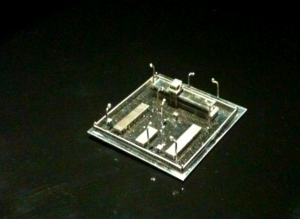 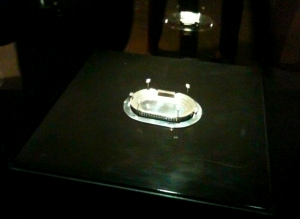
This year’s theme is politics. Seeing a piece like this cuban one reminds me of Art-Jewellery and how the choice itself of being an art-jeweller is very much politic.
Last Tuesday October 12th (in a very symbolic Dia de la Raza) the exhibition Think Again: New Latin American Jewelry opened at the Museum of Arts and Design in NYC with a record inaugural attendance of 700 guests. 46 of the 85 artists whose work was presented at the exhibition attended the opening, making it again a cheerful, fun and emotive event. The response of the audience in NYC demonstrates that the arena of contemporary jewellery is ready to really incorporate cultural diversity and the work on display shows the talent, originality and intensity that converge in the work of this talented group of artists from Latin America.
The Otro Diseno Foundation is extremely greatful to the Museum of Arts and Design, its director Holly Hotchner and its jewellery curator Ursula Neuman for the enthusiasm and effort to present Think Again by the first time in the USA. But, above all, we wish to thank all the artist for their trust in this project and the amazing talent that, we hope, will reach other latitudes.





















Last Thrsday 26th of May the Belleve Arts Museum in Washington organized a fantastic reception for the opening of the exhibition Think Twice: New Latin American Jewellery. The reception was much fun and I spent a very good time with some of the exhibition’s artists: Lucia Abdenur, from Brazil; Maca Sotelo, Lorena Lazard and Alcides Fortes from Mexico; and Benjamin Lignel from France. The rest of you were much missed!
The BAM has made an extraordinary effort to present and promote the exhibitions at many levels: a magnificent display, a very interesting education program that includes visits to the exhibition, audio-tours and a touch-screen interactive presentation of the exhibition, as well as a very professional PR program that has granted us a first review in the Seattle times, the most important newspaper in the state. You can view the review here:
http://seattletimes.nwsource.com/html/thearts/2015216964_jewelry03.html
For BAM, the pedagogic scrpit was very important and they made a really good job translating the texts that I was able to write about your work and using the information that you gave me. There were many comments of the audience on how such an interesting and pleasurable the lecture of the exhibition was, which is a combination of contents of the exhibition (your work), the way in which the pieces are displayed and in which the written information is presented. So we feel that we have achieved one of the main goals of the exhibition: to transmit to the audience how do visual artists and jewellery makers from Latin America use nowadays ornaments to talk about the culture they live in.
My deep gratitude to the Bellevue Arts Museum and its staff. Working with them was professional, smooth and really pleasurable. To the audience that has welcomed the exhibition with much interest and warmth. And, of course, to all the Think Artists: they are the hearth of this exhibition.
Valeria Siemelink, Think Twice Curator

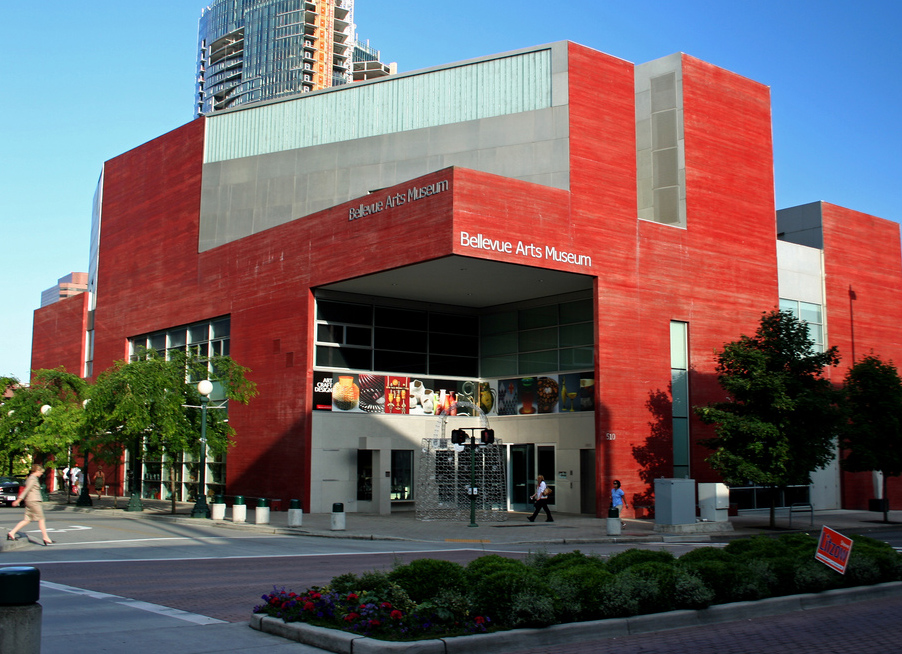
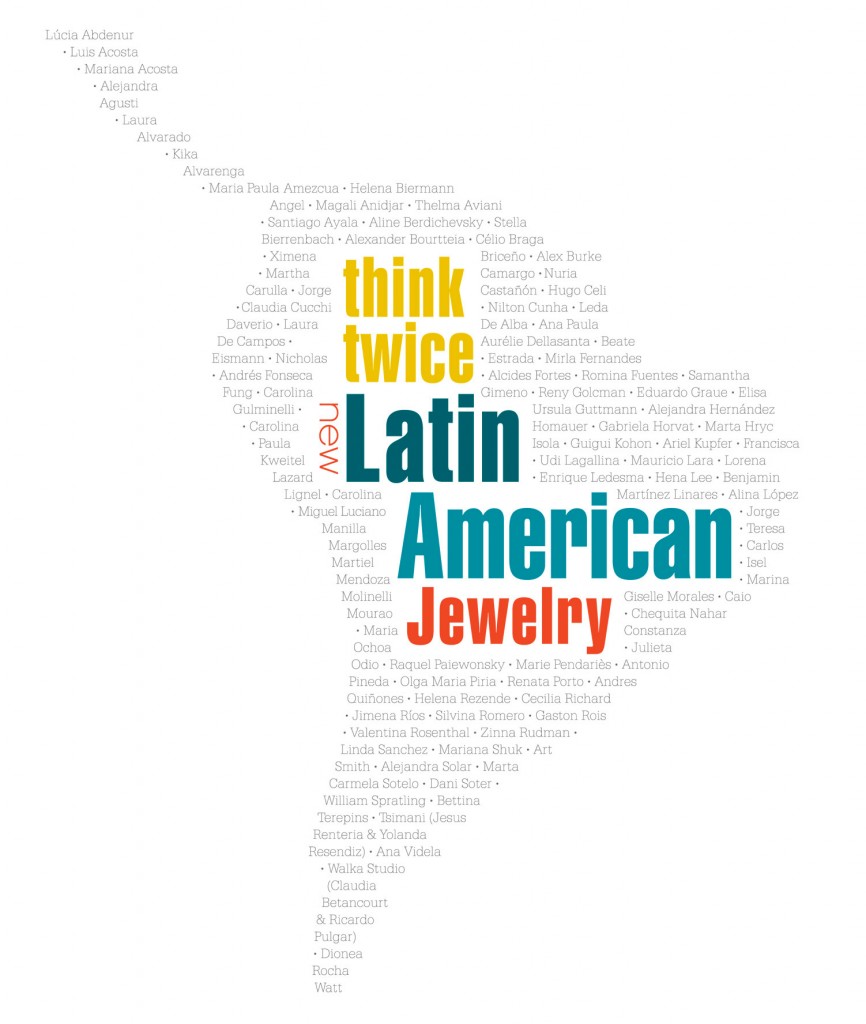

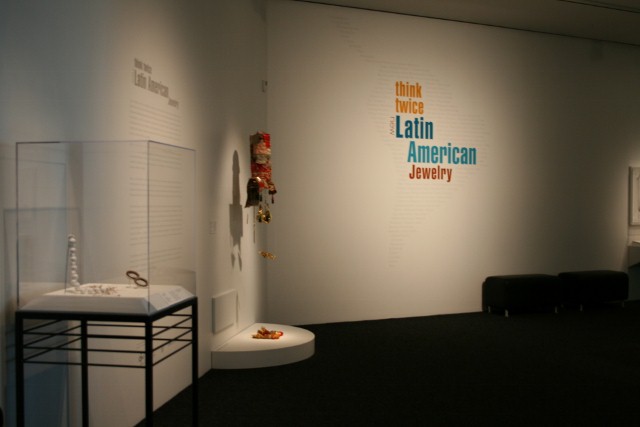
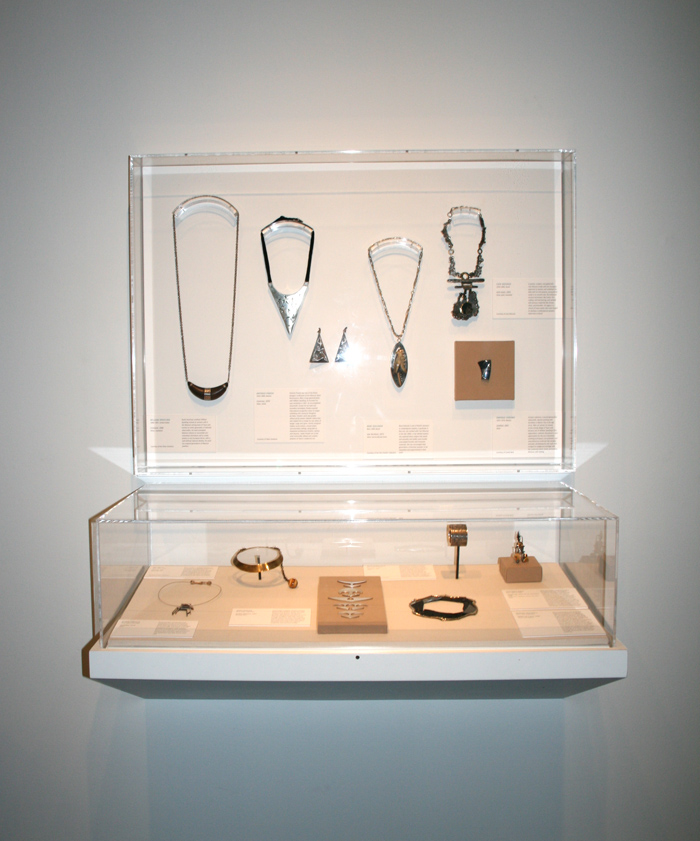

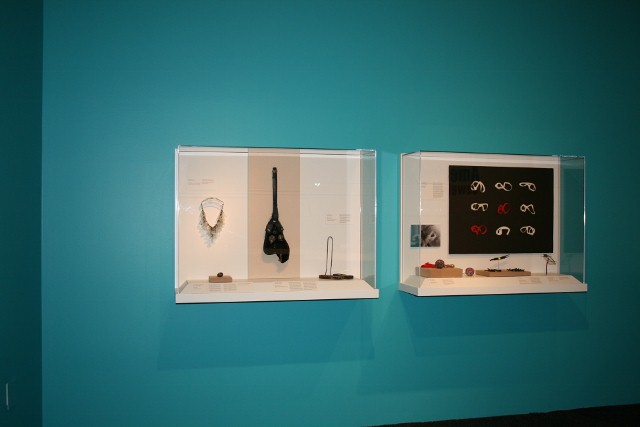
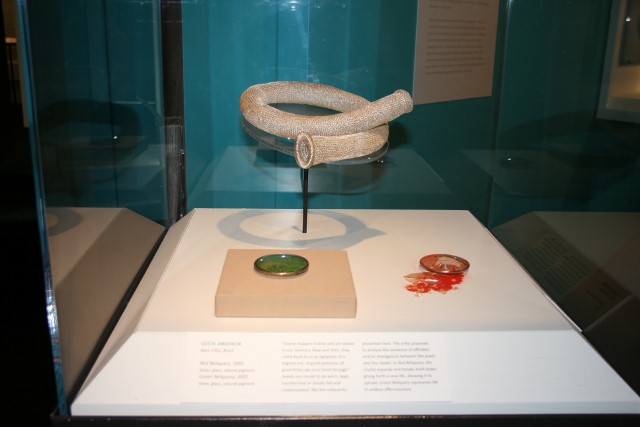

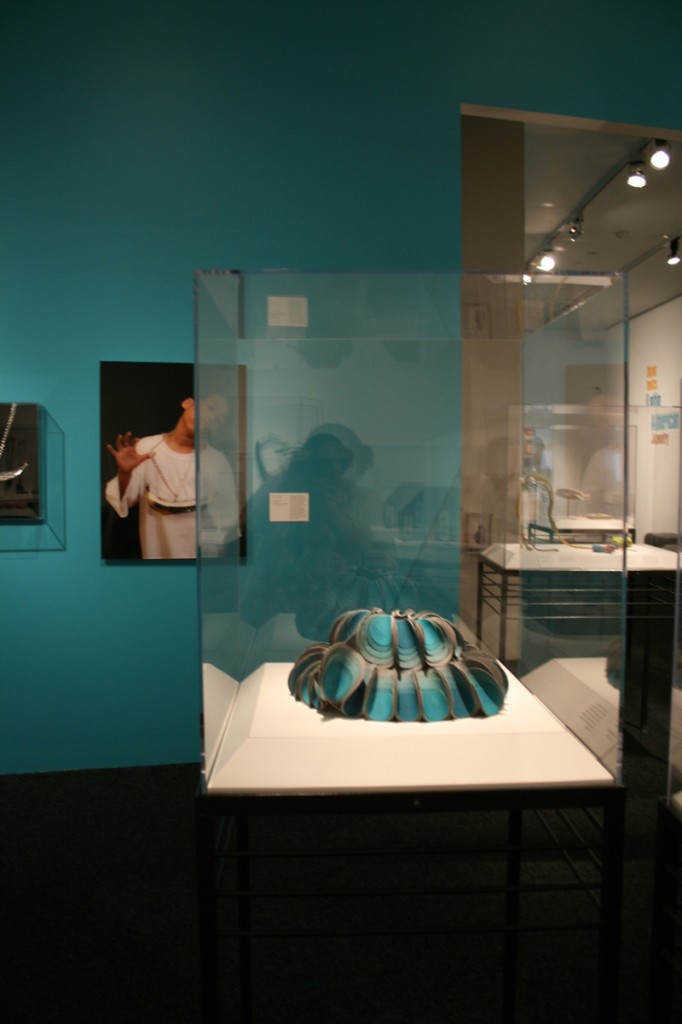
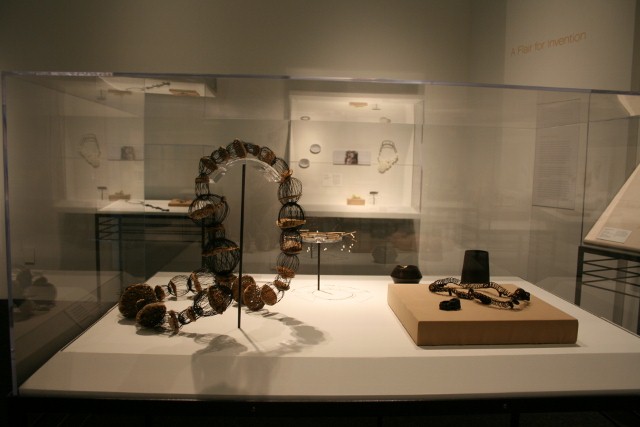
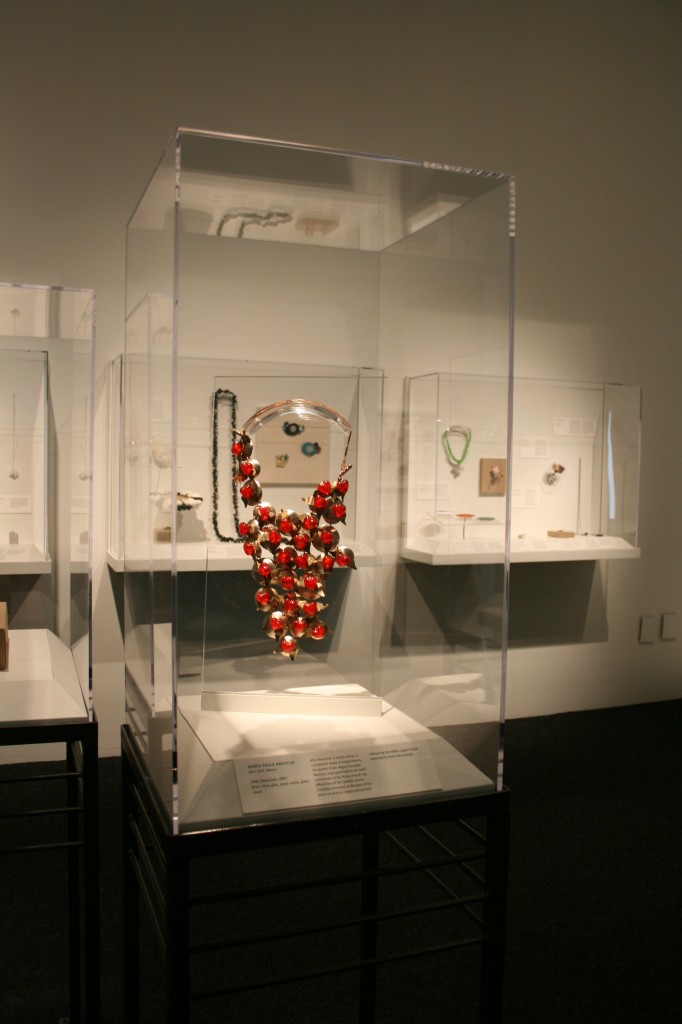
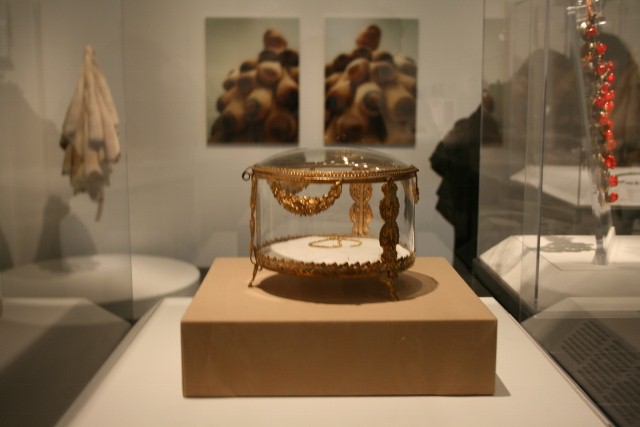
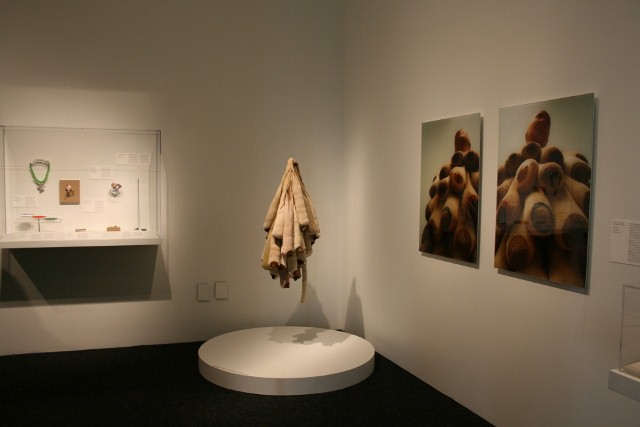

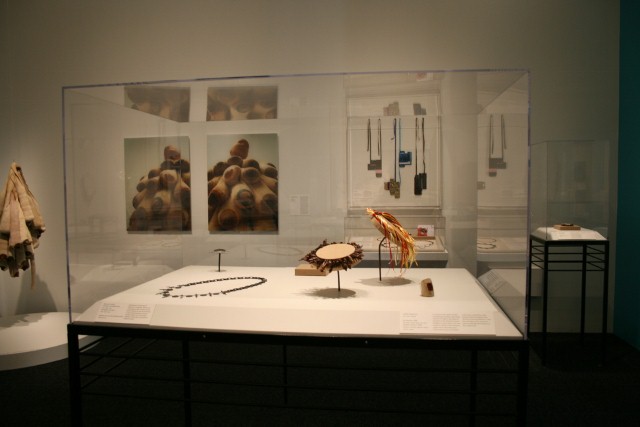

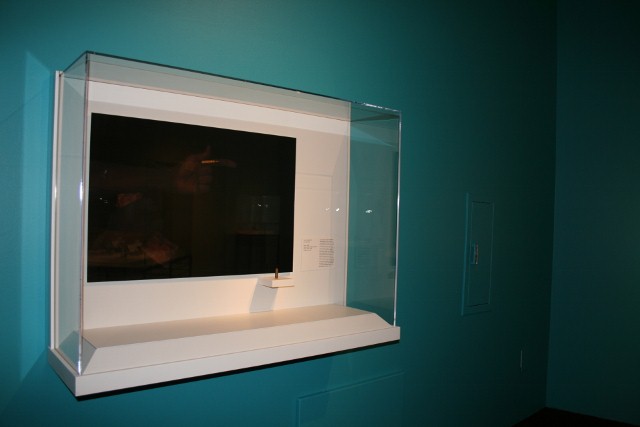


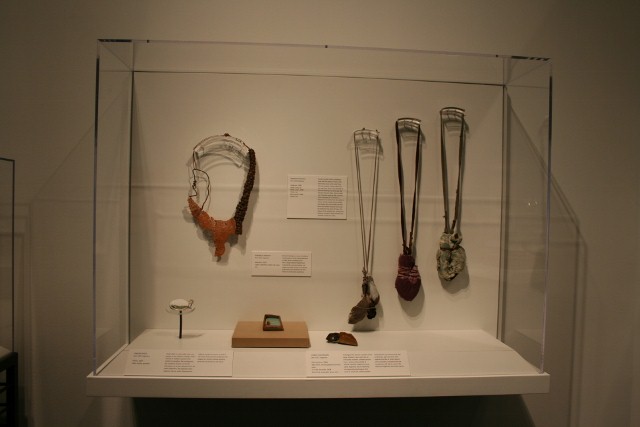
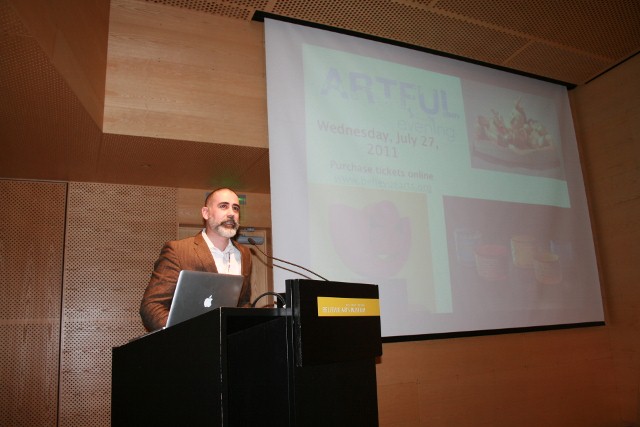
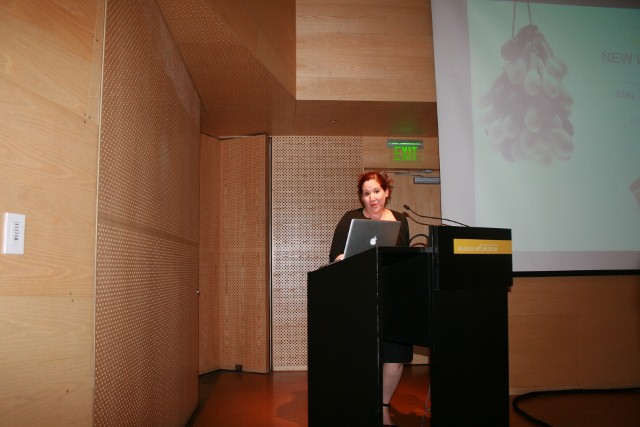
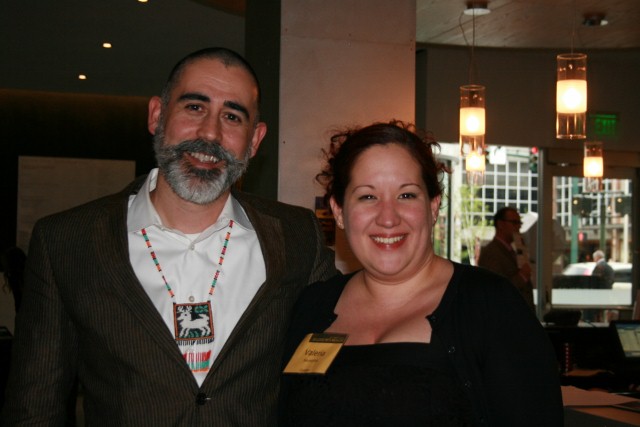


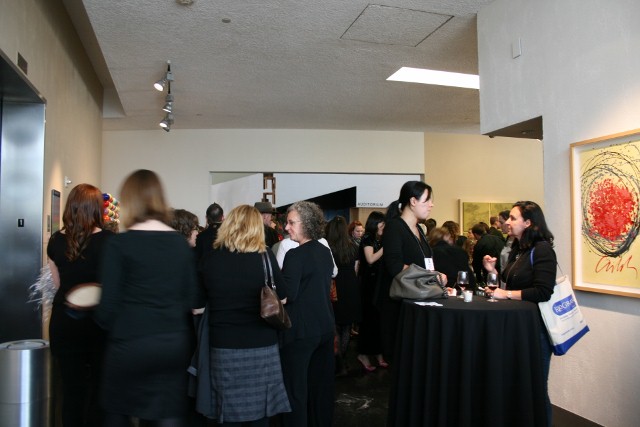
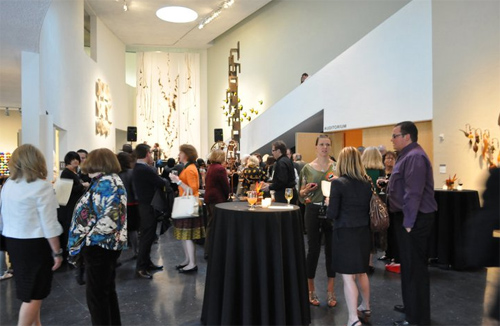

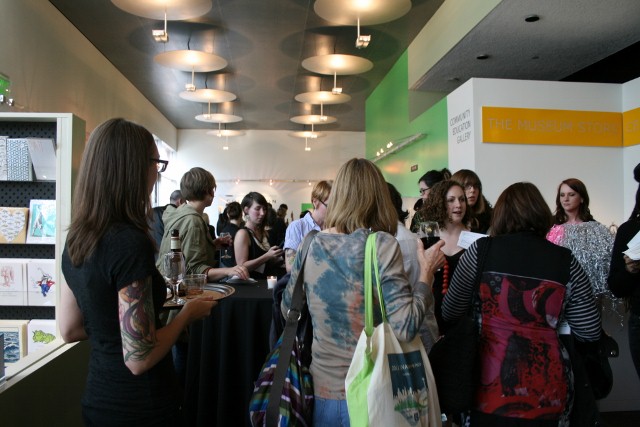

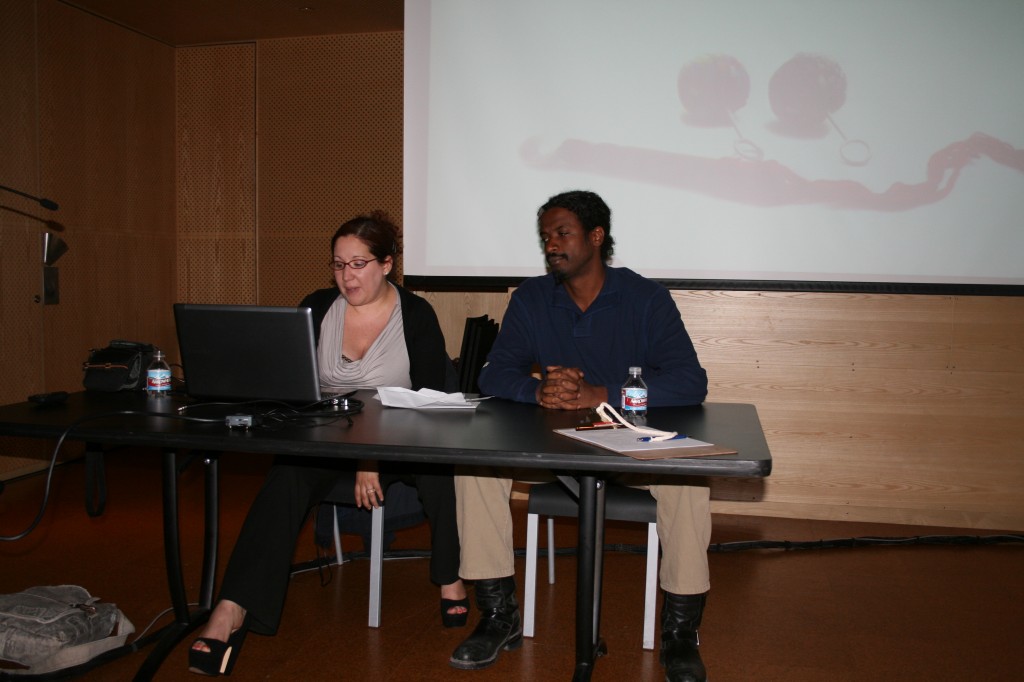
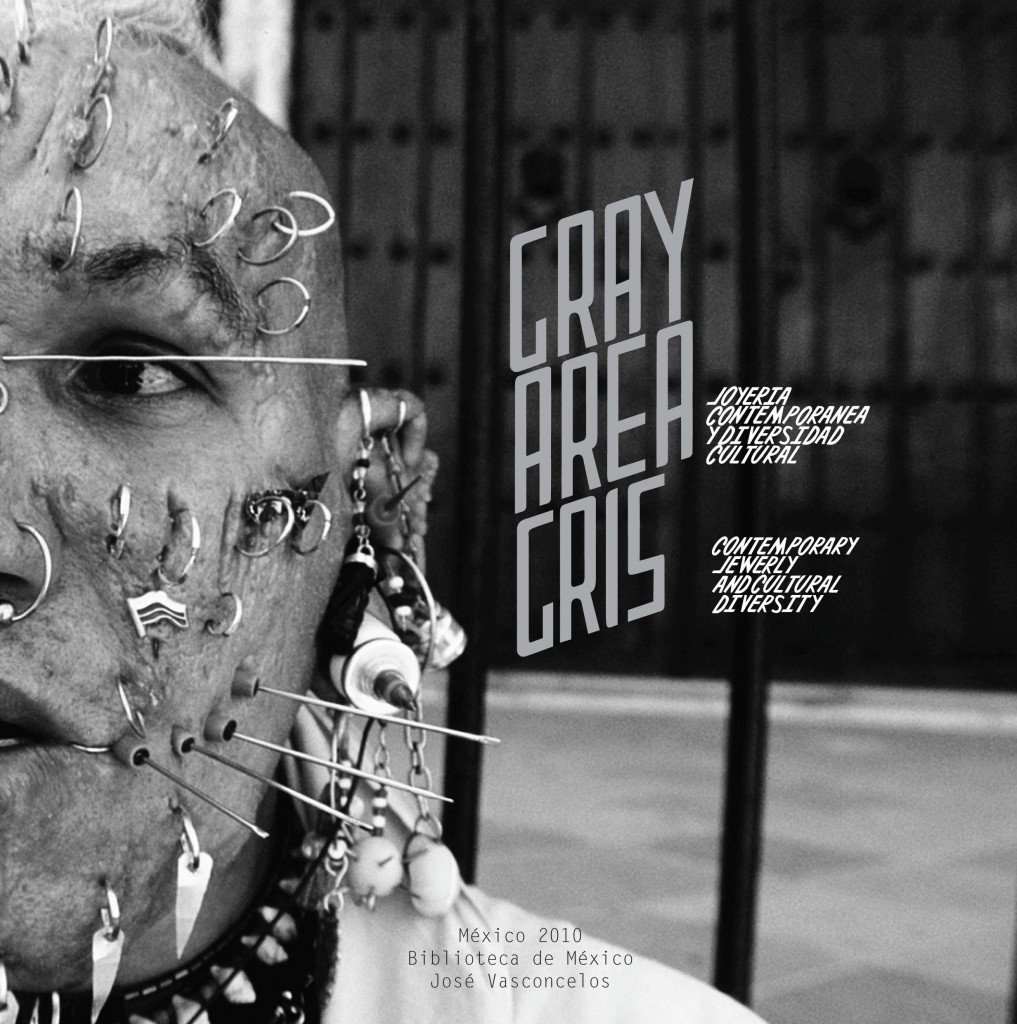
The Gray Area Symposium was an unparalleled
opportunity for the Mexican audience to learn about the
state of contemporary jewellery in the world and, at the
same time, the Symposium served to stimulate cultural
exchange between jewellery artists from Latin America
and Europe.
Organized by the Otro Diseño Foundation for
Cultural Cooperation and Development and supported
by the Prins Claus Fonds, the Mondriaan Foundation
and the Dutch Embassy in Mexico, Gray Area
encouraged a rewarding exchange of ideas from the
perspective of various disciplines, which converged
in an open and much needed debate on the present
and the future of jewellery as a medium for artistic
expression and cultural exchange.
Biblioteca de México “José Vasconcelos”, faithful
to its mission to support and promote national and
international culture, embraced this initiative with great
enthusiasm, offering a space where jewellery artists
from Europe and Latin America were able to exchange
ideas within the frame of the Gray Area International
Symposium.
This proceedings book is a written testimony of the
lectures presented during the encounter as well as a
celebration to initiatives like Gray Area, which help to
enrich and reassert the mission that all the involved
public and private organizations realize
The Gray Area Symposium, which took place in April 2010 at Biblioteca de Mexico José Vasconcelos in Mexico City was an unparalleled opportunity for the Mexican audience to learn about the state of contemporary jewellery in the world and, at the same time, the Symposium served to stimulate cultural exchange between jewellery artists from Latin America, Europe and other corners of the world.
Organized by the Otro Diseño Foundation, Gray Area encouraged a rewarding exchange of ideas from the perspective of various disciplines, which converged in an open and much needed debate on the present and the future of jewellery as a medium for artistic expression and cultural exchange.
This proceedings book is a written testimony of the lectures presented during the encounter as well as a celebration to initiatives like Gray Area, which help to enrich and reassert the mission that all the involved public and private organizations realize realize in favor of cultural cooperation and exchange.
The book include essays by Liesbeth den Besten (NL), Jorge Manilla (Mexico), Cristina Filipe (Portugal), Damian Skinner (NZ), Valeria Siemelink (Mexico),Miguel Luciano (Puerto Rico), Monica Gaspar (Spain) and Mirla Fernandes (Brazil) among many others.
Gray Area Gris: contemporay jewellery and cultural diversity
Consejo Nacional para la Cultura y las Artes
Bilingual edition: English and Spanish
245 pages
Full color, soft cover
Price: 28, 00 Euros
The book is available at museums and galleries in Latin America and Europe or can be ordered here:
https://spreadsheets.google.com/spreadsheet/viewform?formkey=dFBQN09zZWVyOVlDWmdaQmdfVU5qZXc6MQ
For wholesale inquires please contact: exhibitions@otro-diseno.com
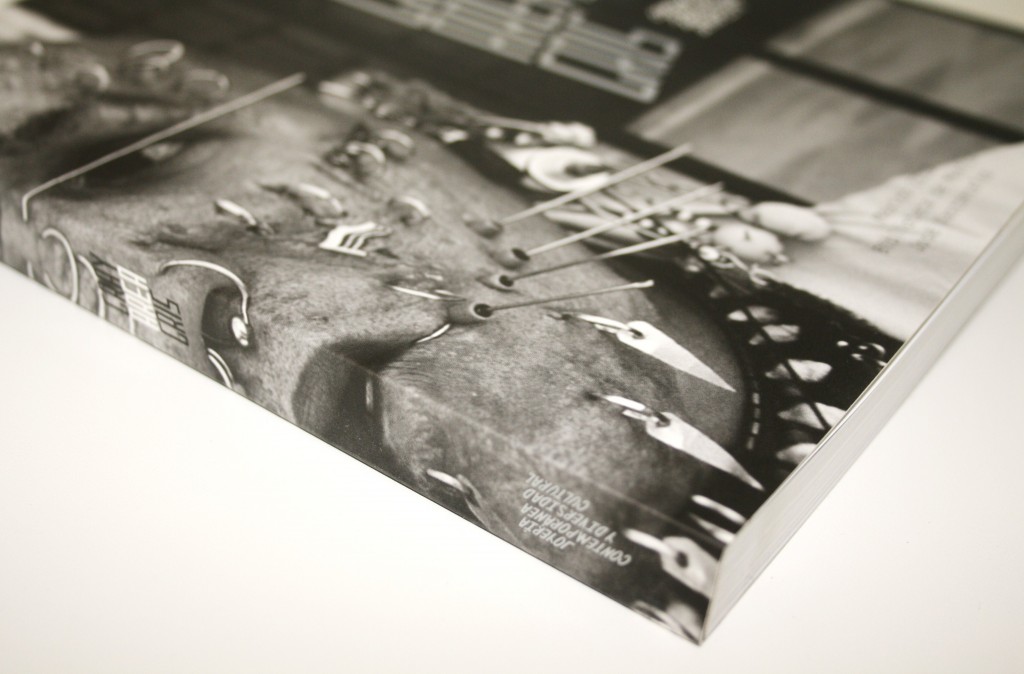
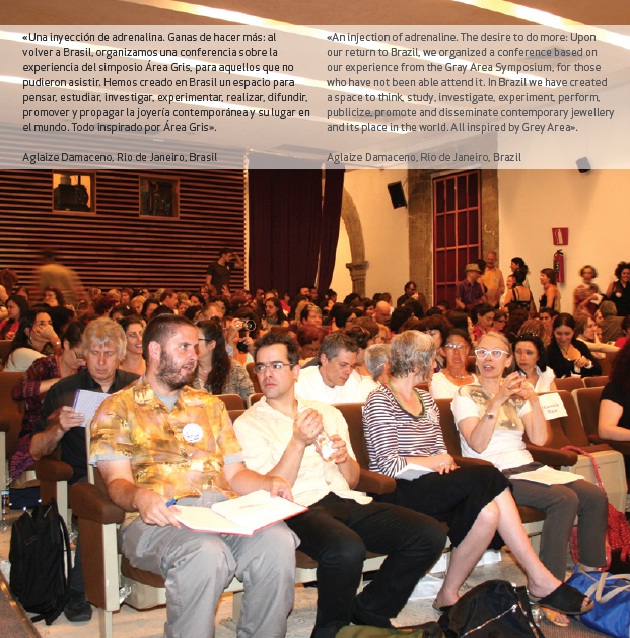
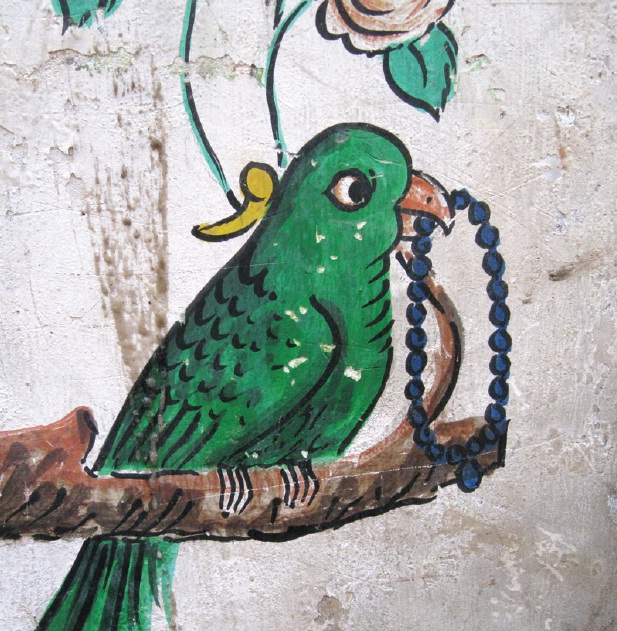
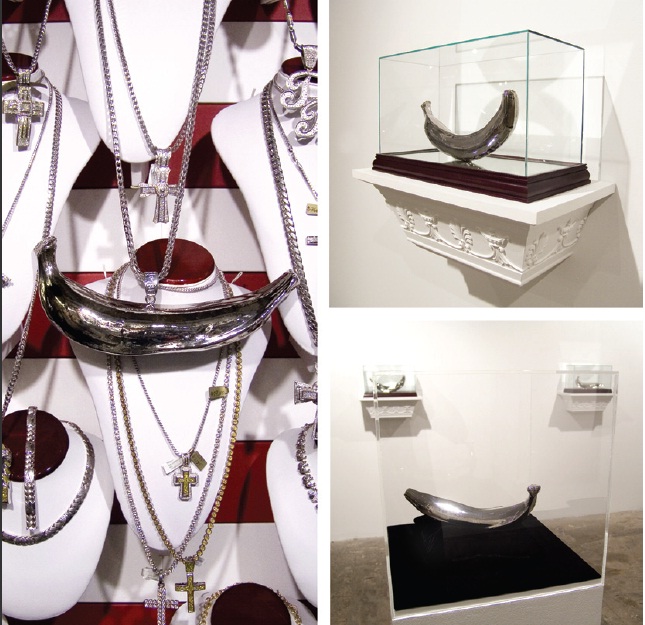
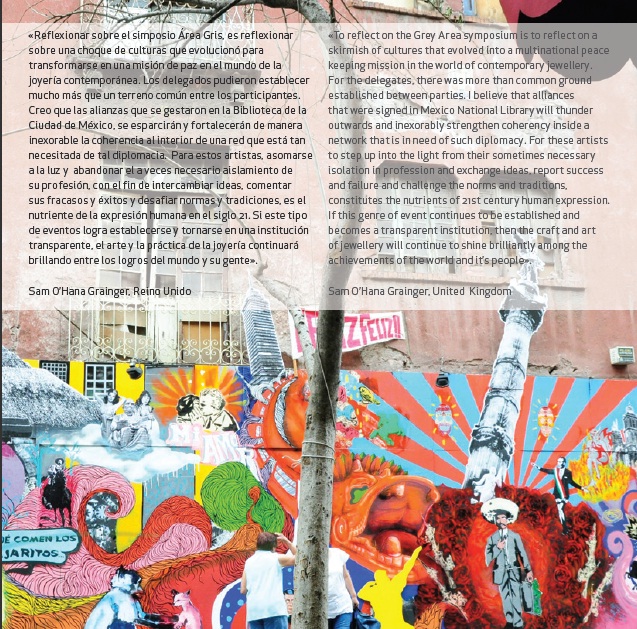
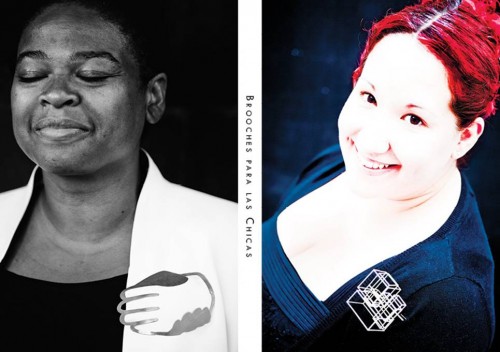
Sieraad Art Fair, Booth 65
Westergasfabriek Amsterdam
November 3rd to 6th 2011
Broches para las Chicas is the third edition of an academic project by the Royal Academy of Fine Arts in Antwerp. Students of the 2nd and 3rd bachelor courses at the jewellery department were asked to design and produce ornaments for a specific person. Past editions of the project have seen Walter Van Beirendock, Marnic Smessaert, Anita Evenepoel and Marjan Unger portraying rings and necklaces produced by the Academy’s students.
This year the academy invited Surinam-born designer and jewellery artist Chequita Nahar and myself to commission the students to create a type of ornament that we both have found alluring and, at the same time, foreign to our habitual choice of jewellery: brooches. Brooches are one the oldest type of jewellery and they are among the most frequently produced ornaments by contemporary jewelers: their possibilities are almost endless and its prominent area of display makes the brooch a remarkable media for communication.
The students were challenged to produce brooches that would help us commissioners to become acquainted with the use of these ornaments and that could establish a relation with the geocultural area we come from, Latin America, and the place where we live now: Europe.
Designing for another person starts at the Academy as an exercise that students will have to master through their entire careers as professional jewellery makers. Their ideas, experience and talents are faced with the tastes, dislikes and demands of someone they come to know through a few working sessions. This results in a great opportunity for the students to acquire real-life experience and for the audience to be treated with the promise of surprising young talents.
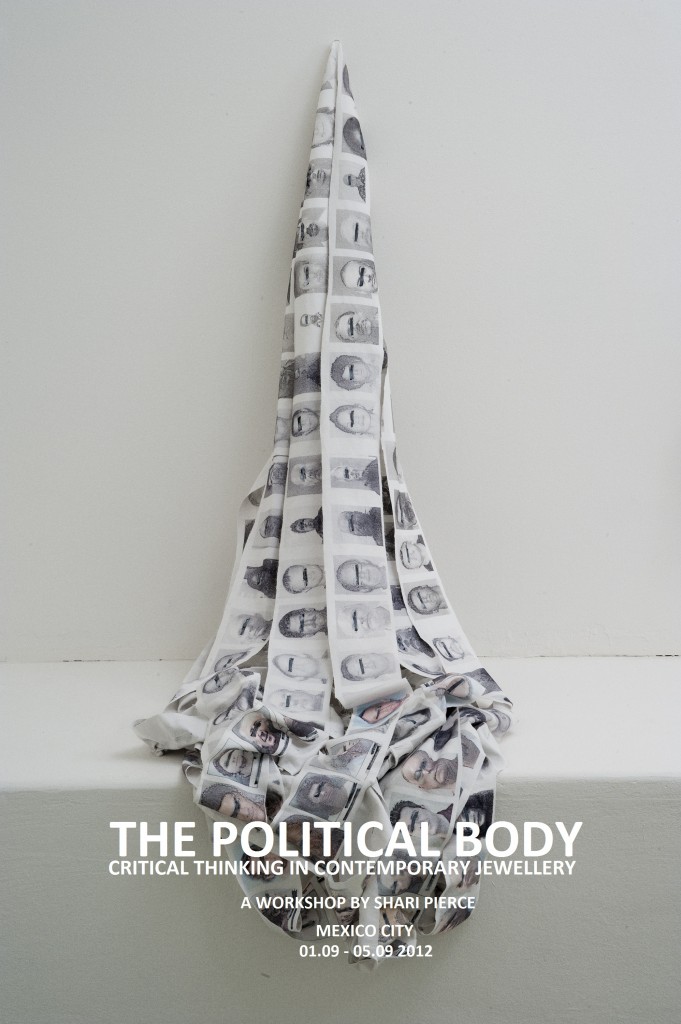
Workshop The Political Body
Critical Thinking in Contemporary JewelleryA workshop by Shari Pierce
01. 09. 2012 – 05.09.2011
Mexico City |
| The Otro Diseño Foundation and Taller Serra invite to the workshop The Political Body, by visual and jewelley artist Shari Pierce. This workshop is the first of a series that Otro Diseño will carry out in Mexico in a two year period. The program, which will include periodical lectures and discussion panels, aims to offer Mexican jewellery makers, designers and visual artists the opportunity to explore a global notion of contemporary jewellery by addressing complex conceptual matters as well as technical and material innovation within the context of their own cultural background. The program seeks to offer Mexican jewellery artists the tools to strengthen scene of contemporary jewellery in their own country as well as to actively engage with the international arena.The Political Body workshop seeks to promote political, social and emotionally engaged creative expression within the art form of contemporary jewelry. This creative expression empowers the individual and the group, by creating a space in which you can engage in a dialogue with one another about the issues in which you have a personal stake in your society.
By exploring the possibility of communicating a message through the political body, students will gain a better understanding of contemporary jewelry and its potential for social, political and emotional artistic expression.
For additional information, please go to:
http://www.eventbrite.com/event/3846669492
—–
Shari Pierce was born in New Your and currently lives in Munich, Germany. She holds a degree in Fine Arts by the East Carolina University and earned a MFA at the Academy of Fine Arts in Munich.
She has been a guest professor at the Konstfack University College of Art, Crafts and Design in Stockholm, the Geneva University of Art and Design in Switzerland and the Rhode Island School of Art and Design, in the USA.
http://www.sharipierce.com/ |

From September 5th to October 7th, the work of Buenos Aires based jeweller Jorge Castañón will be on display at the Gallery Velvet da Vinci in San Francisco, California.
Castañón is a former marine biologist who studied sculpture and carpentry and trained for almost 10 years in various traditional silver and goldsmithing workshops. By developing impressive technical skills and combining them with a profound understanding of local materials and autochthonous crafting techniques, as well as a powerful and sophisticated aesthetic sensibility, Castañón produces highly expressive pieces that breake the boundaries of jewelry to take on sculptural characteristics. Inspired mostly by natural materials and shapes and concerned with environmental matters, Castañón searched for rare types of wood, preferably discarded or abandoned, weathered by use or nature. Often preserving vestiges of its past life—paint flecks, a rusty nail, or discoloration caused by fungi—the wood becomes a protagonist in Castañon’s pieces, while rich metals are humbled and used in service to the wood to provide structural support or add color. The work express a marked Argentinean identity through a universal language.
While working on pieces inspired by “Alice in Wonderland,” Castañón explored the emotional impact of endless holes, and hidden places away from the light. He discuses this experience in the ‘realm of doubt’ as the impetuous for his first wood pieces:
“I wanted to talk about abundance, but suddenly knew that I was actually talking about what is not there, the void, and I found myself again making bowls, hollows filled with nothing or almost nothing. Since then, I kept on looking for hidden places, old hiding places, crevices, containers of many things and of nothing at the same time, inhabited by silent presences. Now I invent them, construct them, give them voice. I rescue objects and materials that were on the way to oblivion and return to communicate a minimal story.
Jorge Castañón founded his well-known school “La Nave,” 20 years ago and was featured in the Munich Schmuck 2011 Exhibition.
http://www.velvetdavinci.com/show.php?sid=152
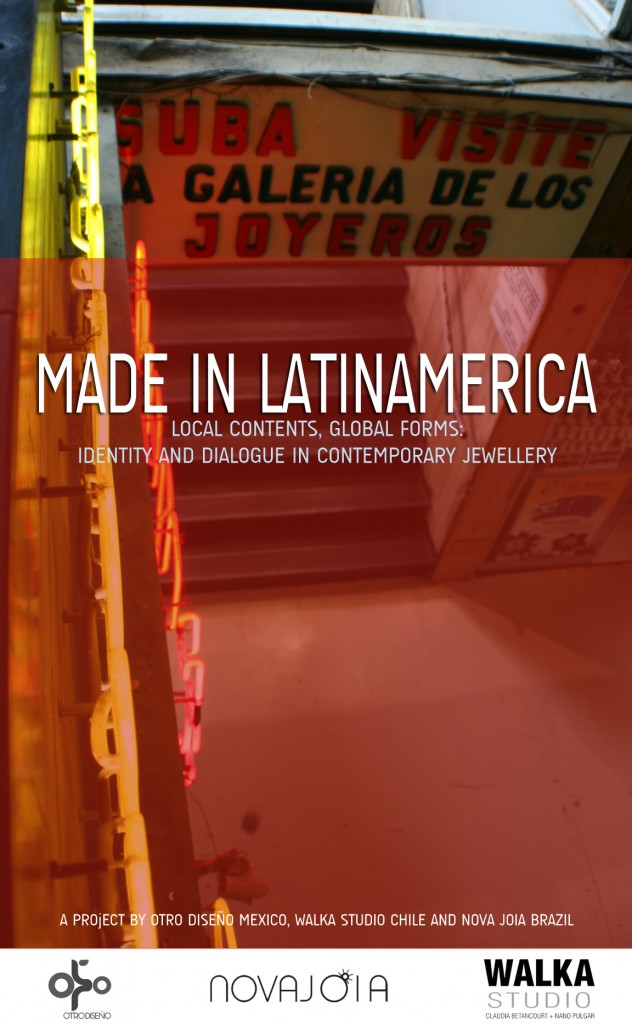
The Otro Diseño Foundation is pleased to announce its alliance with the organizations NovaJoia, from Brazil and Walka Studio, from Chile. This alliance has specifically been brought together to promote the broadening, development, understanding and appreciation of contemporary jewellery as a medium of cultural expression from and within Latin American and the Caribbean and to stimulate its engagement into international dialogue.
Our goal is to generate opportunities for jewelers and artists from Latin America to explore the creative and communicative potential of jewellery and for a broader audience to become acquainted with the contemporary jewelry practices of the continent.
This will be achieved through Made In Latinamerica, a three year pilot project that will focus in three areas:
THINK. The creation of Laboratorio de Ideas, a PanAmerican, multidisciplinary think thank which stimulates the vigorous and creative analysis and theorizing of contemporary jewellery. Through Laboratorio de Ideas we aim to assert the character of Latin American jewellery by seeking out ways to transform and alter existing notions about the region, while presenting competing ideas about what constitutes its particular sensibility and, at the same time, further develop its ability to communicate globally.
LEARN. The implementation of Taller Viajero, a comprehensive educational program based in a more liberal understanding of jewellery and consisting of a series of nine different workshops, each of which will travel to the different regions of Latin America. Taller Viajero aims will provide jewellery makers from Latin America a challenging environment that encourages unorthodox thinking and experimentation and enables them to assert a powerful personal language while developing a consistent and professionally executed body of work. The program is open to jewellery artists residing in Latin America interested in developing the concept of jewellery as a form of artistic expression and wishing to perform in a global environment.
DISSEMINATE. The development of an exhibition program which will produce at least three exhibitions, conceived with the highest standards of scholarship, display, and interaction with the public and which show the work of professional and emergent contemporary jewellery makers from Latin America. These exhibitions aim to create provide the regional audience the opportunity to become familiar with the concept of contemporary jewellery and to an international audience with the cultural framework to understand the jewellery practices from the continent.
Made in Latin America will be launched in September 2012 within the frame of the first workshop of the series: The Political Body, by American jewellery artist Shari Pierce.

The Otro Diseño Foundation is pleased to announce the appointment of Martacarmela Sotelo as head of our Mexico chapter, effective September 1st 2012.
Martacarmela Sotelo, born and currently living in Mexico City, holds a degree in architecture by the Iberoamerican University in Mexico and and MAFA by the Central Saint Martins College of Art and Design, UK. An established jewellery maker, her work has been featured at the Museum of Arts and Design NY, the Marion Friedman Gallery in London and the Popular Art Museum of Buenos Aires, among others, and she has been honored with prices such as the Premio Quorum Mexico 2012. Ms. Sotelo is a strong advocate for the development of contemporary jewellery in Mexico and participates in lectures and round tables around the country.
With her new appointment as Head of the Otro Diseño in Mexico, Martacarmela Sotelo seeks to further the Foundation’s mission to foster awareness, understanding and appreciation of contemporary design from Latin America as well as to nurture design excellence through the encouragement of cultural exchange. Ms. Sotelo brings to the Otro Diseño Foundation a broad understanding of the field of contemporary jewellery, both regionally and internationally, as well as extensive experience in the organization of cultural and educational projects. In the coming years, she will be in charge of developing a training and exhibition’s program that aims to generate opportunities for Mexican jewelers and artists to explore the creative and communicative potential of jewellery and for a broader audience to become acquainted the contemporary jewelry practices of the country. Ms. Sotelo will also act as a link between Mexico and other Latin-American individuals and organizations.
Ms. Sotelo comments: “It is a great honor for me to have been appointed as head of Otro Diseño Mexico; ours is a country with a tremendous creative potential. A continuous and sustained exchange of knowledge and ideas is vital among jewellery makers from Mexico, Latin America and the rest of the world. I am proud to be in the midst of this important project and I am looking forward to strengthen the existing links in the field and to forge new ones”.
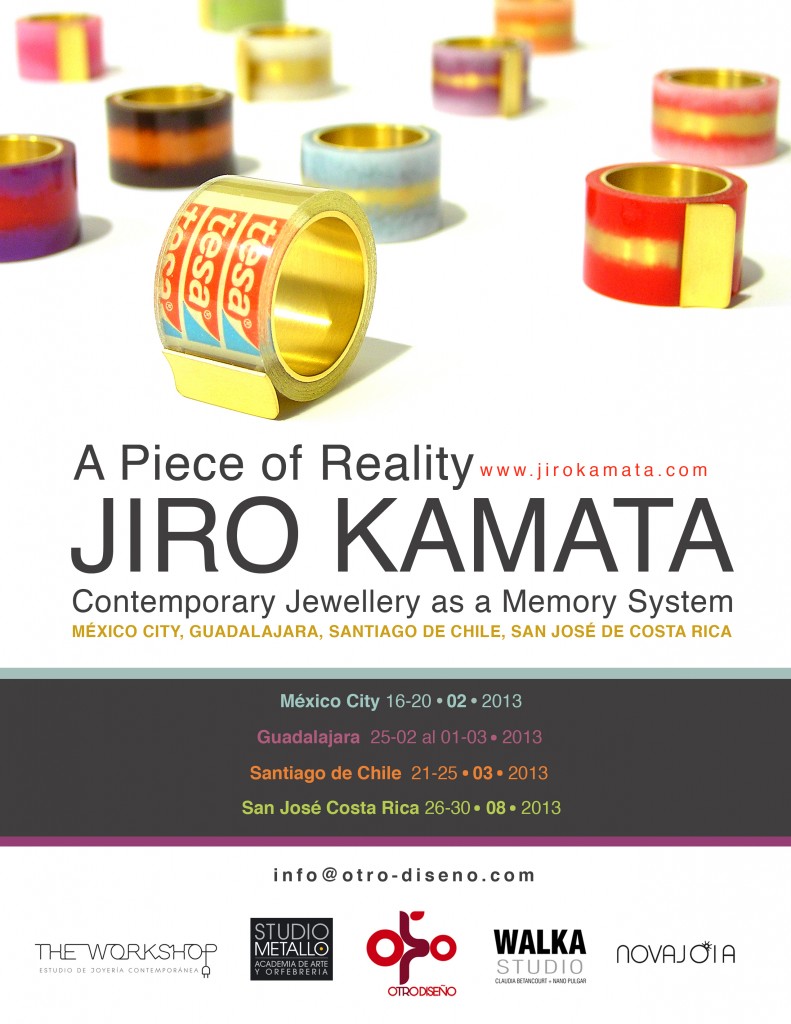
Travelling Workshop No 2: A Piece of Reality, Contemporary Jewellery as a Memory
16.02 – 20.02.2013Taller Tierra y Plata, Mexico City |
The Otro Diseño Foundation (y la sede local) invite(s) to the workshop ‘A Piece of Reality: Contemporary Jewellery as a Memory System’, dictated by the Japanese artist Jiro Kamata.
‘A Piece of Reality’ is the second workshop in the series ‘Travelling Workshop’, an initiative of Otro Diseño Mexico, Walka Studio Chile and NovaJoia Brazil, which aims to offer jewelers, designers and visual artists who live in Latin America the opportunity to address the global notion of contemporary jewellery by the exploration of conceptual and critical thinking and the application of materials, techniques and technology according as a response to that line of thought. The program seeks to offer jewelers of this cultural region the tools to define their individual position as an artist, strengthen their respective national scenes and participate actively in the international arena of contemporary jewellery.
Jewelry, through history, has functioned as a memento, capable of safeguarding through time events relevant to an individual or community. ‘A Piece or Reality’ addresses the role of contemporary jewellery as a memorial object and its appropriation of portable recording technology. During the workshop Jiro Kamata will use his iconic ‘Tesa Ring’ as a starting point to analyze the relationship between concepts, materials and techniques and encourage participants to explore the creative potential of jewelry as a powerful tool of social communication.
For more information visit: www.otro-diseno.com/tallerviajero/apieceofreality
Registration at: http://www.eventbrite.com/event/5009236762?utm_source=eb_email&utm_medium=email&utm_campaign=new_eventv2&utm_term=eventname_text
Other venues and dates in Latin America:
Guadalajara, México
25.02.2013 – 01.03.2013
http://theworkshop-studio.com/2012/12/10/a-piece-of-realitycontemporary-jewellery-as-a-memory-system-by-jiro-kamata/
Santiago de Chile
21.03.2013 – 15.03.2013
http://clasesdejoyeria-vitacura-walka.blogspot.nl/
San José, Costa Rica
26.08.2013 – 30.08.2013
http://www.studiometallo.com/
—-
About Jiro Kamata
Jiro Kamata was born in Hirosaki, Japan. He studied jewellery at the Yamanashi Institute in Kofu and became later a student of Otto Künzli at the Fine Arts Academy in Munchen, city where he lives and works since 2000.
Jiro Kamata is an assistant professor at the Fine Arts Academy in Munchen. His work is featured in exhibitions around the world and in private and public collections such as the V&A Museum in London, the Stedelijk Museum in Amsterdam or the Hiko Mizuno Collection in Tokyo.
www.jirokamata.com


Galería NUDO Arte Contempráneo in collaboration with Otro Diseño present the exhibition Arboresque by Jiro Kamata
from 22.02 to 08.03
at NUDO Arte Contemporáneo at Hotel Posada Carmina
Cuna de Allende No 7, Centro, San Miguel de Allende
Opening 22.02.2013 at 19:00 hrs
www.galerianudo.com
The Arboresque Series
In 2010 Jiro Kamata visited Mexico for the first time to exhibit Momentopia, a series he had been working in since 2007. The open, blue sky of Mexico captivated the visiting artist and introduced him to a sensorial experience that led him to explore Mexican color and to develop a profound visual relation with the country. This proved to be a great source of inspiration for Kamata, who understood local colour beyond the abstract theory. His gaze was particularly incisive on the street, where he took time to study both grandiose and vernacular architecture and connect it in a remarkable way why the people who produce and experience it. The hand-forged wrought iron detailing, so abundant in colonial towns, attracted Kamata’s attention. Arabesque, a form of decoration based on rhythmic linear patterns of scrolling and interlacing foliage and tendrils, originated within the Islamic art and became an important part of Spanish architecture which was later exported to Mexico. The irresistible combination of unexpected colour palettes and the capricious shapes of the iron arabesques led the Momentopia series to a surprisingly fresh and colorful path.
Momentopia represent moments captured by photographic cameras, using old camera lenses, minimal compositions and a rather monochromatic palette where faint and fleeting color is occasionally provided by the different coatings of each lens. The trip to Mexico led Kamata to an inexorable and organic development of Momentopia. Camera lenses are again the starting point of Arboresque. But, impeccably encased in oxidized silver profiles, the precise and constricted shapes of Momentopia, branch out in Arboresque, creating sinuous and mysterious patterns that remind of unfinished calligraphic strokes of a language we do not fully recognize.
An unusual, bolder use of color is immediately noticed in Arboresque, where most of them display bi-color combinations: an eroding green wall, revealing layers of deep purple beneath; a blue pickup truck, brimming with yellow marigold blossoms; a woman in a white dress, pink flowers in her hair, spinning to the rhythm of a festive orchestra; the deep blue sky of a Mexican evening, stained with the darkest rain clouds. By applying acrylic and acetone and using the Japanese ancient suminagashi technique to decorate paper, Kamata masterfully re-interprets Mexico’s coulorful palette.
Kamata has experienced Mexico in a profound, reflective and sensuous way. He faced an ancient, complex and fascinating country in the most visual and aesthetic way, unafraid of playing and experimenting with images, emotions and memories. While eating tacos, dinking tequila and dancing danzon, he analyzed the Mexican life and landscape with curious and humorous eyes. His findings, embodied in the new jewellery series, seem to say: ‘look, here is another way of portraying Mexican colour’. As a Mexican architect well acquainted with the colours of my country, I can only agree.
Valeria Siemelink

The Estonian Academy of Arts, the Estonian Museum of Art and Design and Otro Diseño organize a lecture program within the frame of the exhibition Think Twice: New Latin American Jewellery, to take place on 22.02.2013 at 10:00 at the Estonian Academy of Art.
Program:
10:00 Welcoming words by Ketli Tiitsar
10:10 Introduction by Think Twice curator Valeria Vallarta Siemelink
10:20 Artistic Migration: Aesthetics of Lack of Authenticity Martha Hryc (Poland / Mexico)
10:45 A Never Ending Journey by Carolina Gimeno (Chile)
11:10 Latent Visions by Giselle Morales (Dominican Republic)
11:35 Coffee break
11:55 Ornata: jewellery research in Brazil by Mirla Fernandes (Brazil)
12:20 How About Mexico by Beate Eismann (Germany / Mexico)
12:45 A Side – B Side by Laura Alvarado (Colombia)
13:10 Panel discussion, moderated by Ketli Tiitsar cuartor at the Estonian Museum of Applied Art and Design
13:40 Finishing words
Estonian Academy of Art
Estonia pst 7 / Teatri Väljak 1
Room 245, (II floor)
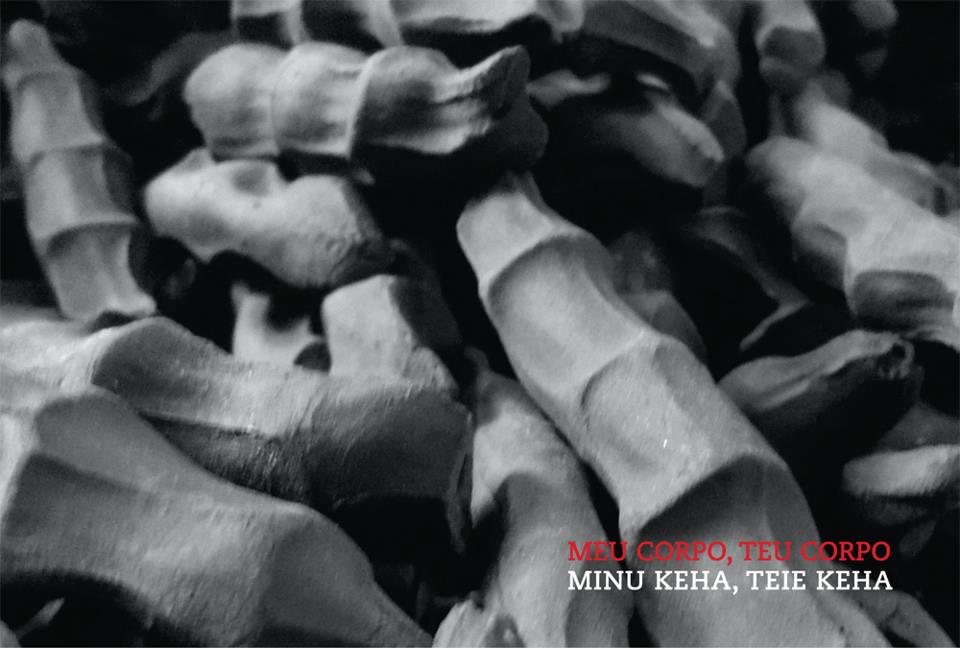
Last Thursday 21st of February, Brazilian artists Mirla Fernandes opened the exhibition Meu Corpo, Teu Corpo (My Body, Your Body) at the Hop Gallery in Tallinn and managed by María Valdma. The show was presented within the frame of the opening of the exhibition Think Twice: New Latin American Jewellery.
The exhibition, curated by Dr. Ana Paula de Campo is a retrospective of twelve years on Fernandes’ research on jewellery and its relation with the body.
Taking her own body as a mould and measure –instead of using the traditional tools of the jeweler- the biochemist and artist highlights the body of the other’s singularity through the retention of her presence in the works. This strategy makes explicit the unique character of the encounter, mediated by the jewel, between the artist and the wearer. Fernandes disrupts the traditional structures of occupation in the body and the use of jewellery through pieces that turn both viewer and wearer into active and interactive subjects, so becoming evident the collective essence of jewellery, and specially, its power to articulate new relations, new constructions and communications abilities.
The show was composed mainly by Fernandes’ production in latex, a Brazilian native material that was once considered more valuable than gold. The paint-like qualities of latex allows the artist a much more gestural approach, convening a subtly fierce expression and intimate qualities to the pieces. A video projected in the gallery’s main wall shows the radical and infinite possibilities in which the pieces can be worn by one or more persons at the same time.
At the center of the square gallery, there was a pile of dark clay cartouches that clearly retained the shape and digital prints of the artist’s hands and fingers. Visitors were allowed to take and keep one of these pieces. In exchange, the wearer offered the artist a photograph of her interaction with the piece.
This exhibition shows how the artist starts and finishes her pieces but that doesn’t end their possibilities. The Tallinn audience has now a chance to prolong the boundaries of Fernandes’ work.
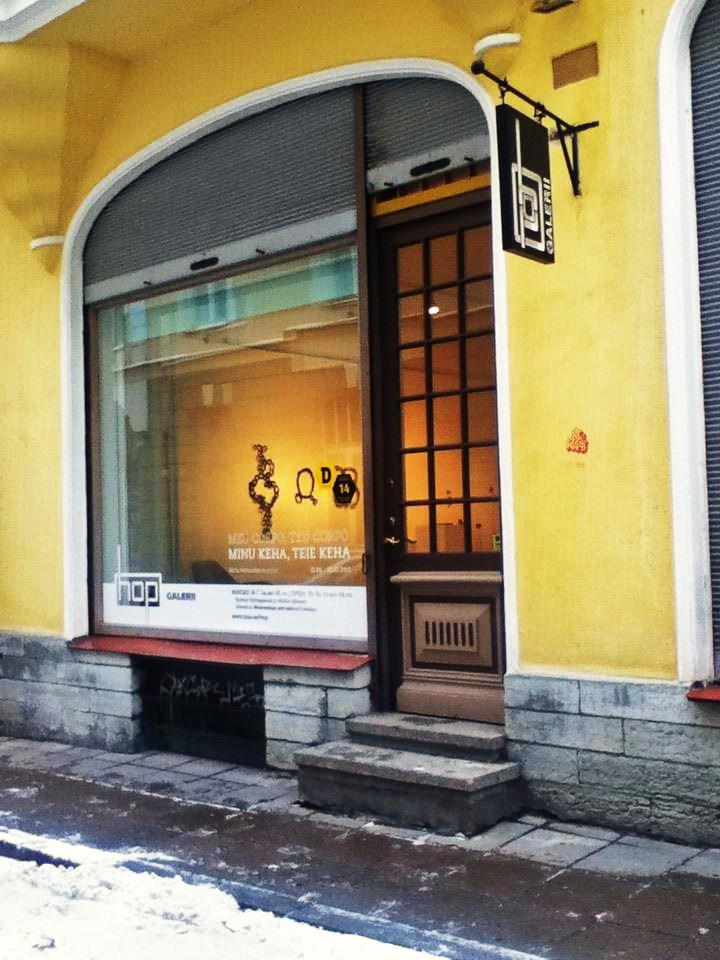
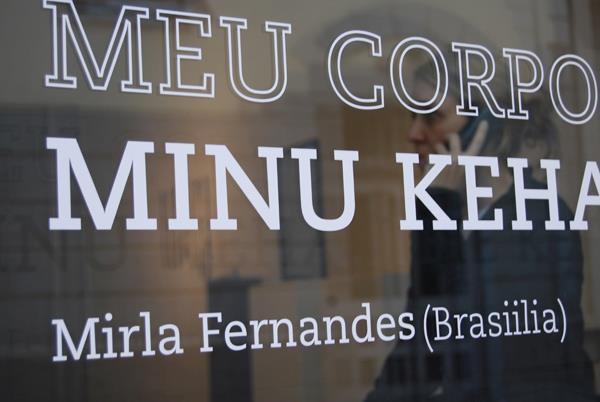
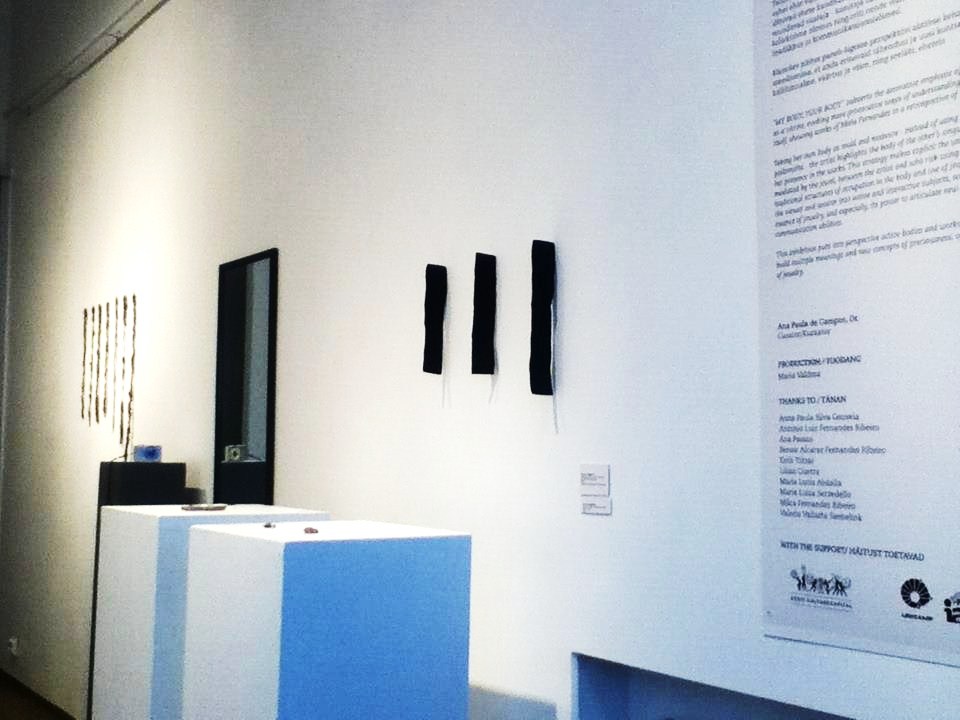
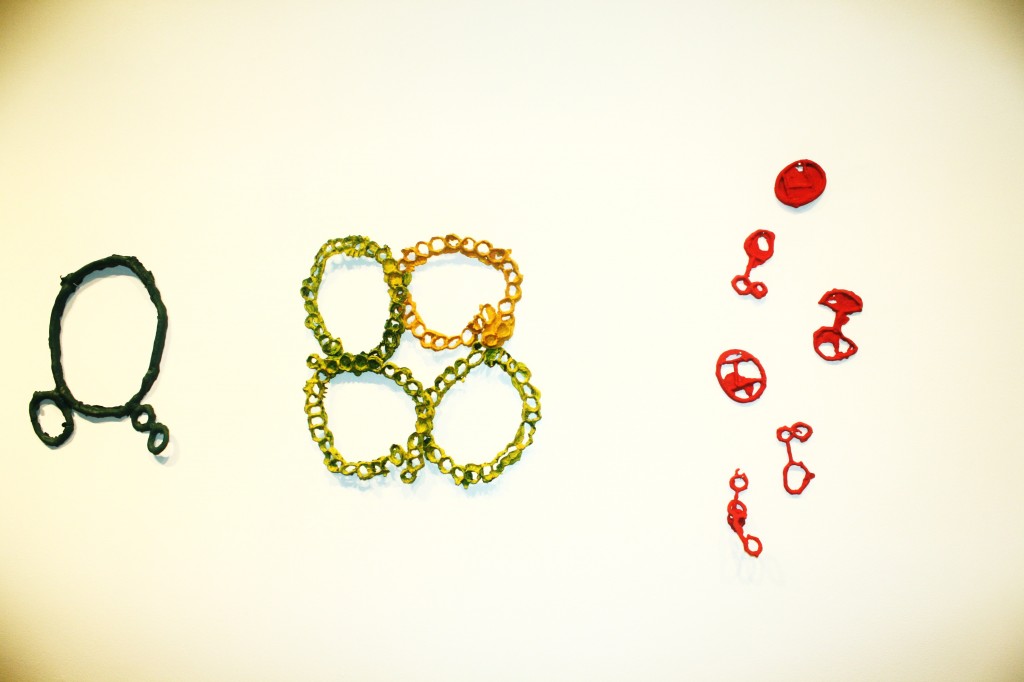
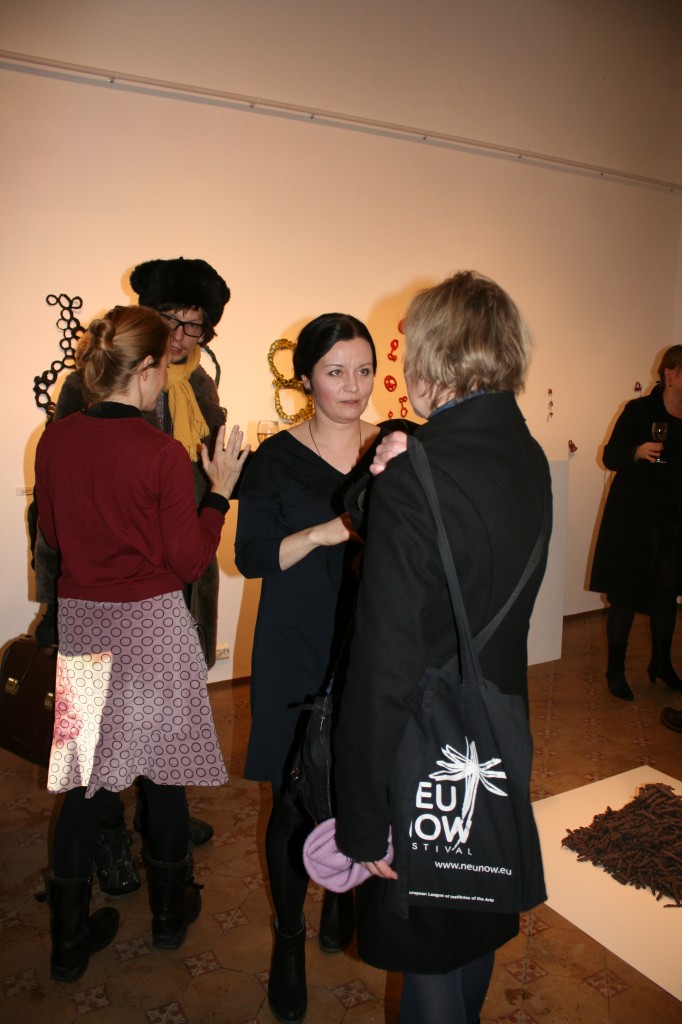
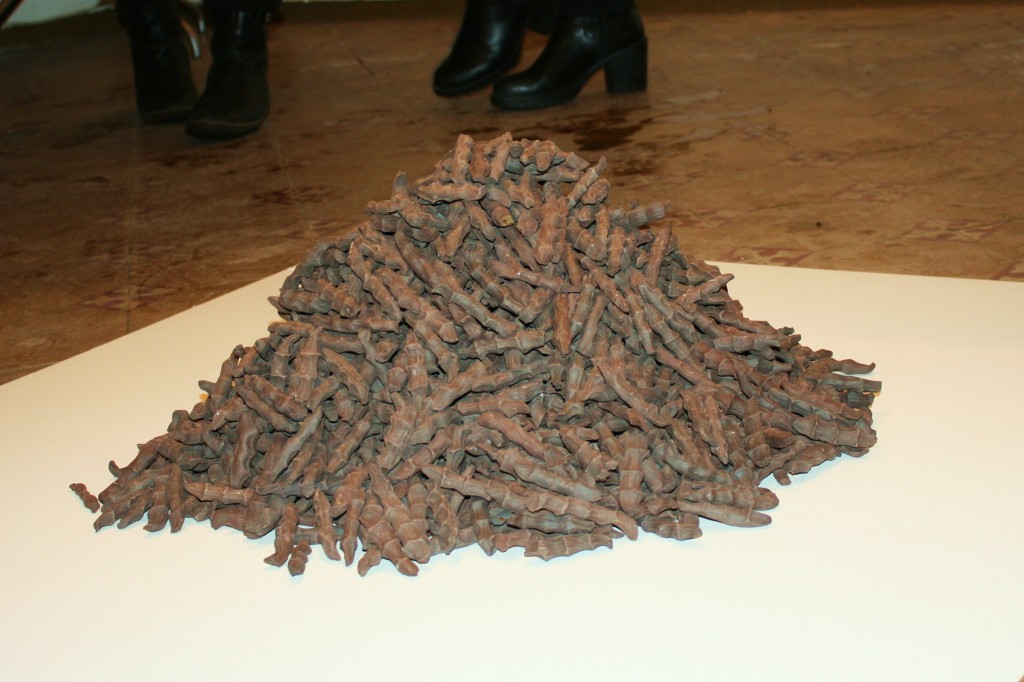
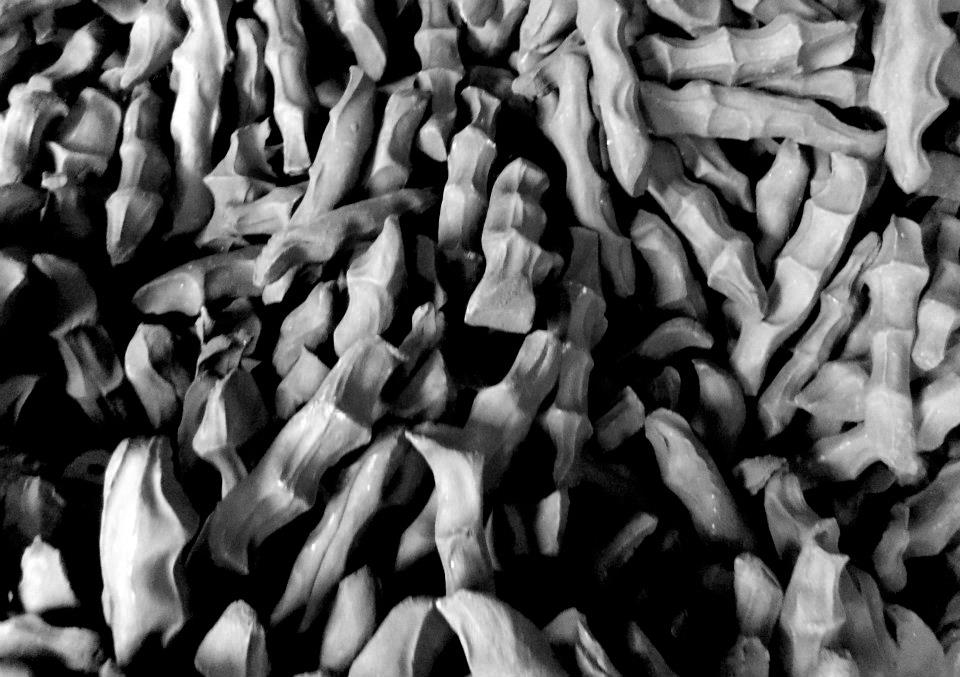
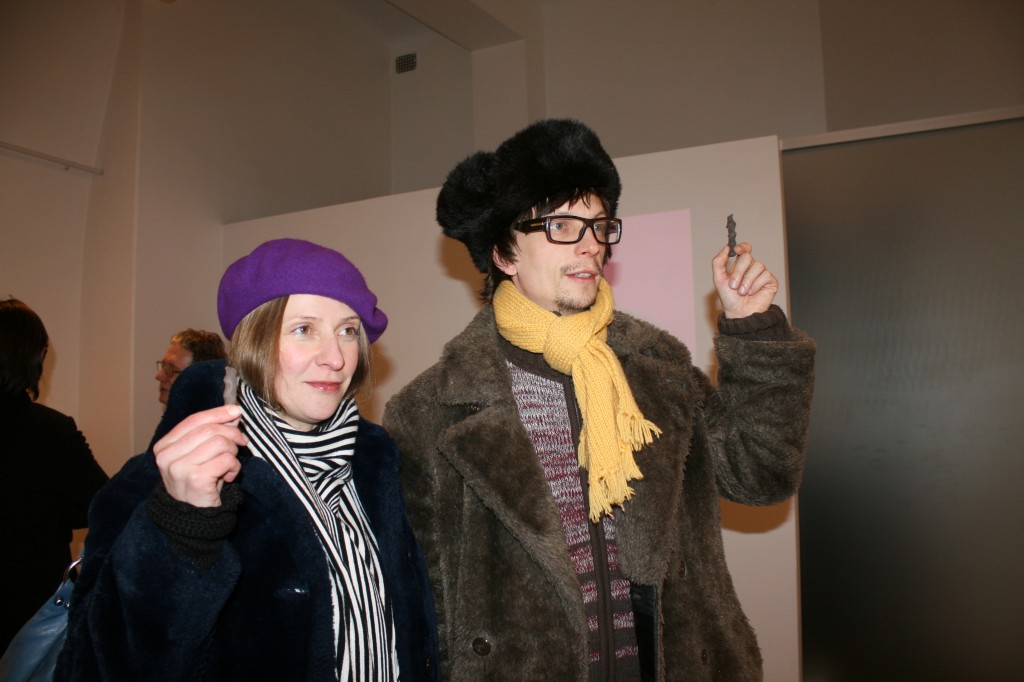

|
|



































![MAD_FACADE_TYPE_ThinkAgain[1] MAD_FACADE_TYPE_ThinkAgain[1]](http://otro-diseno.com/blog/wp-content/uploads/2010/09/MAD_FACADE_TYPE_ThinkAgain1-201x1024.jpg)










































































